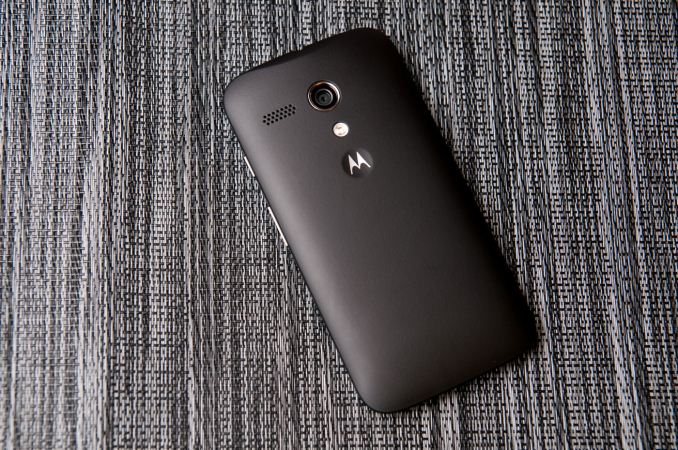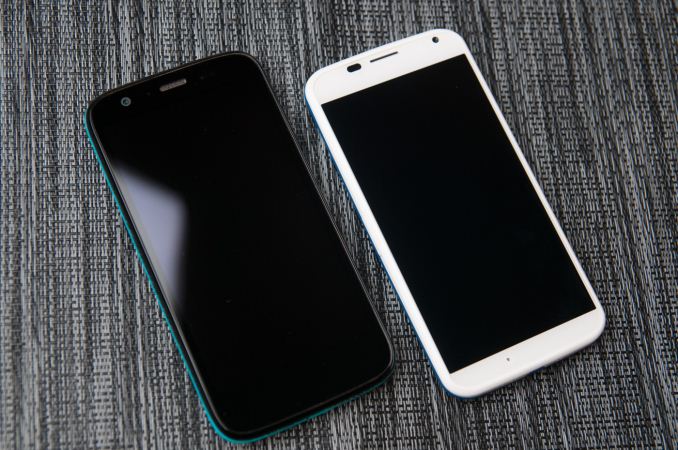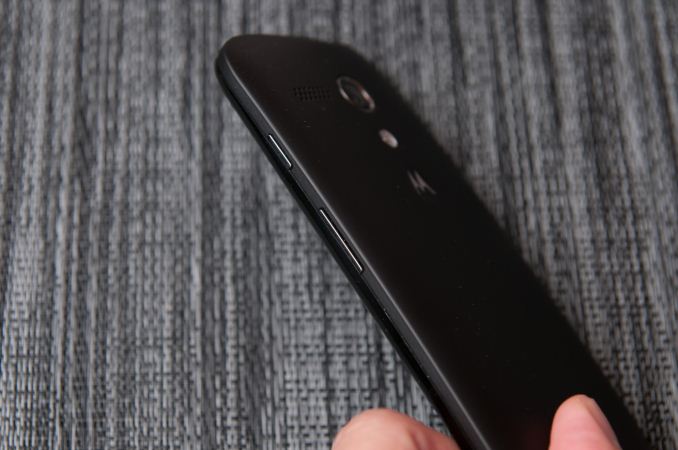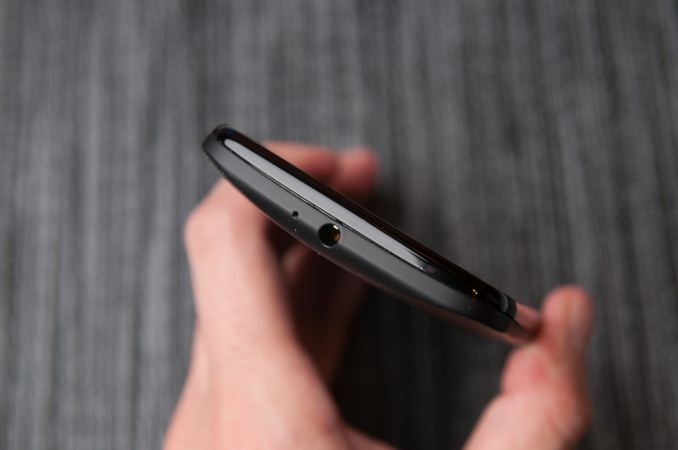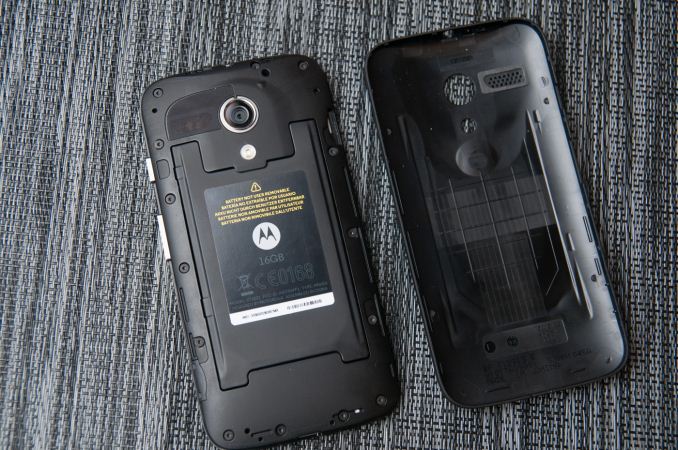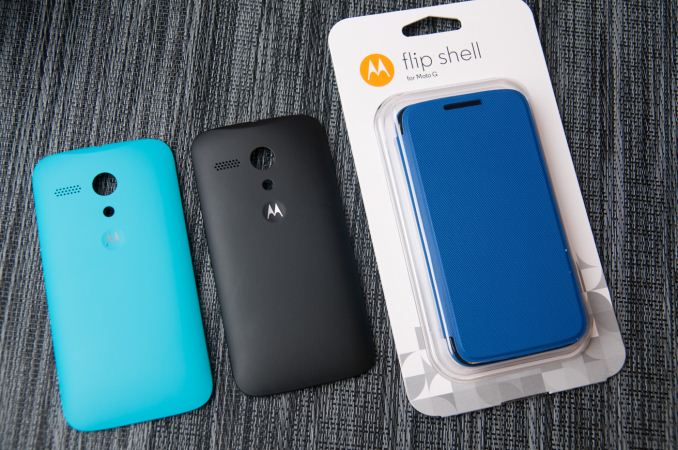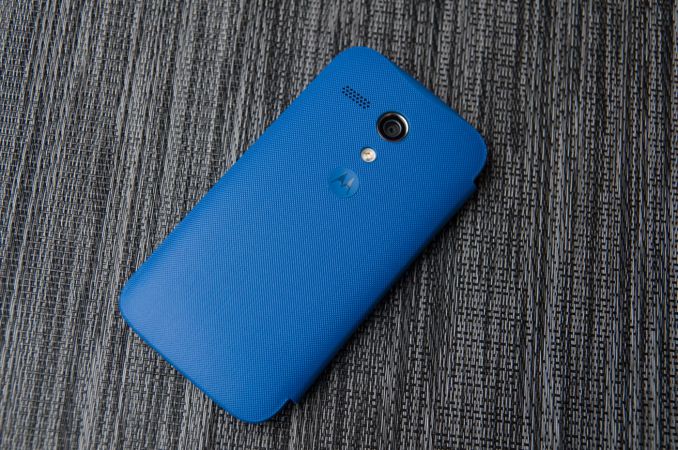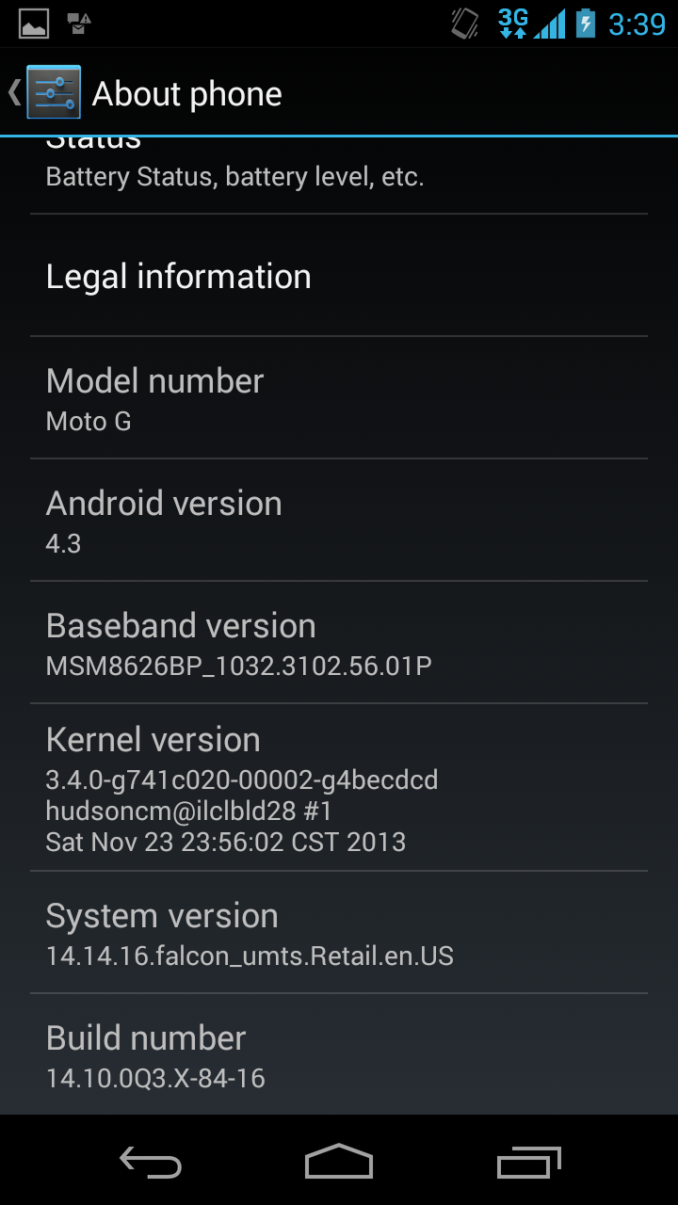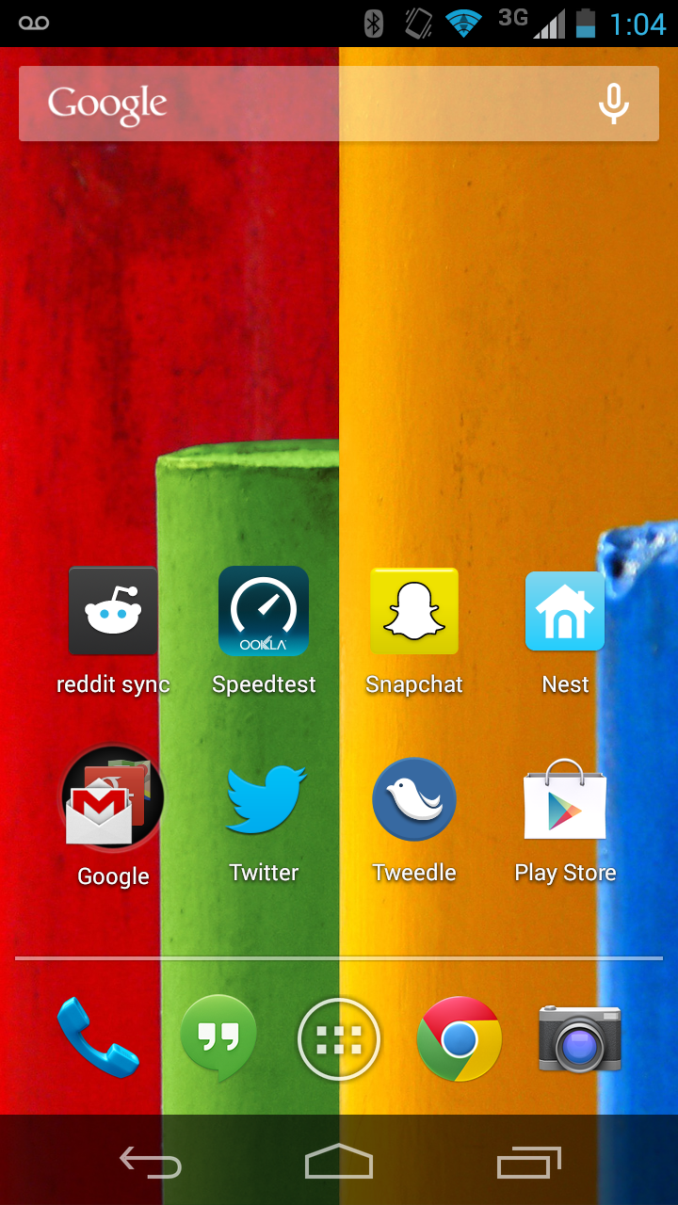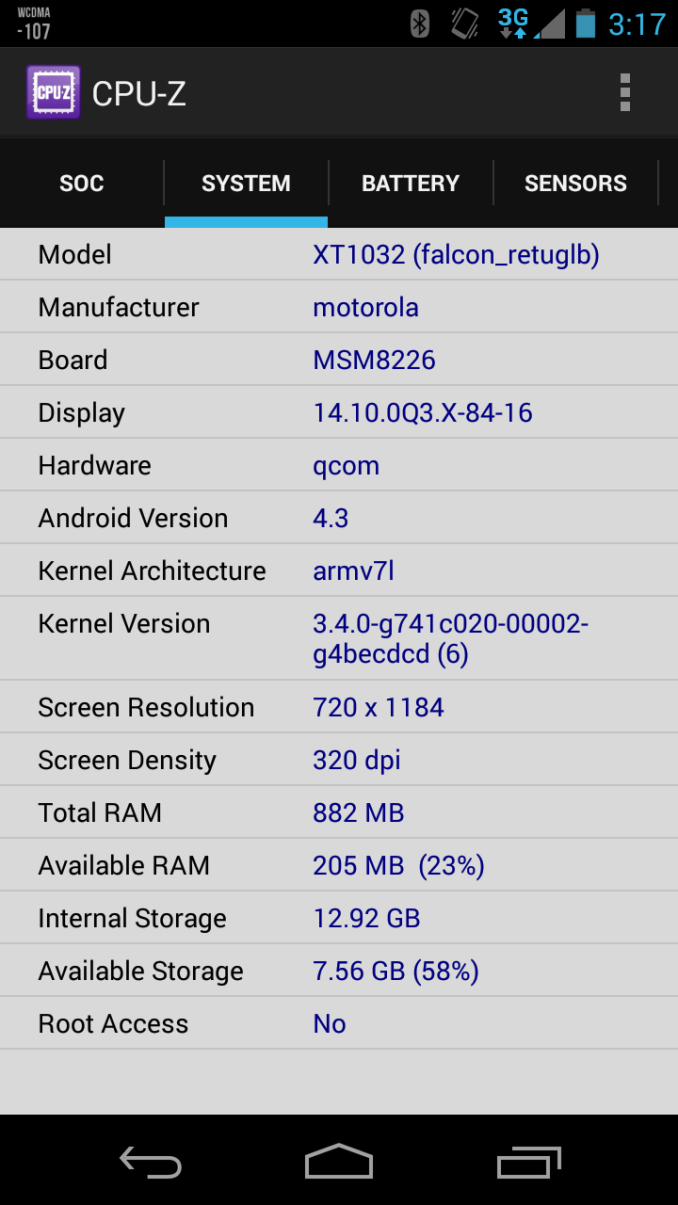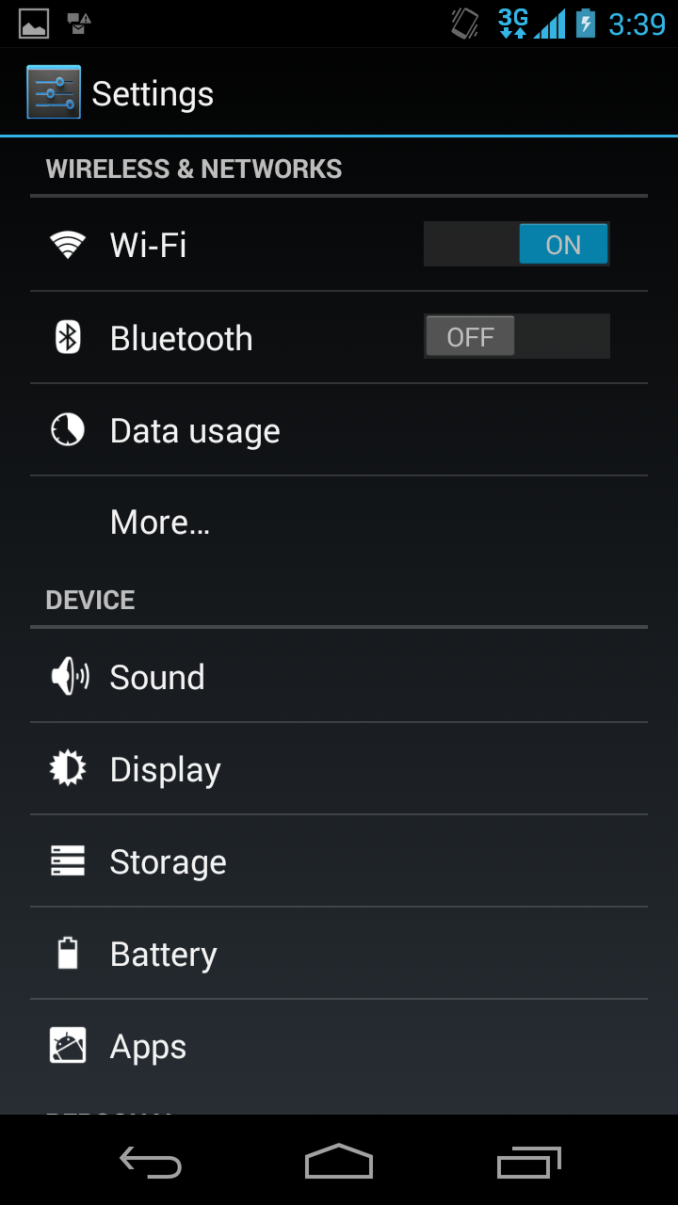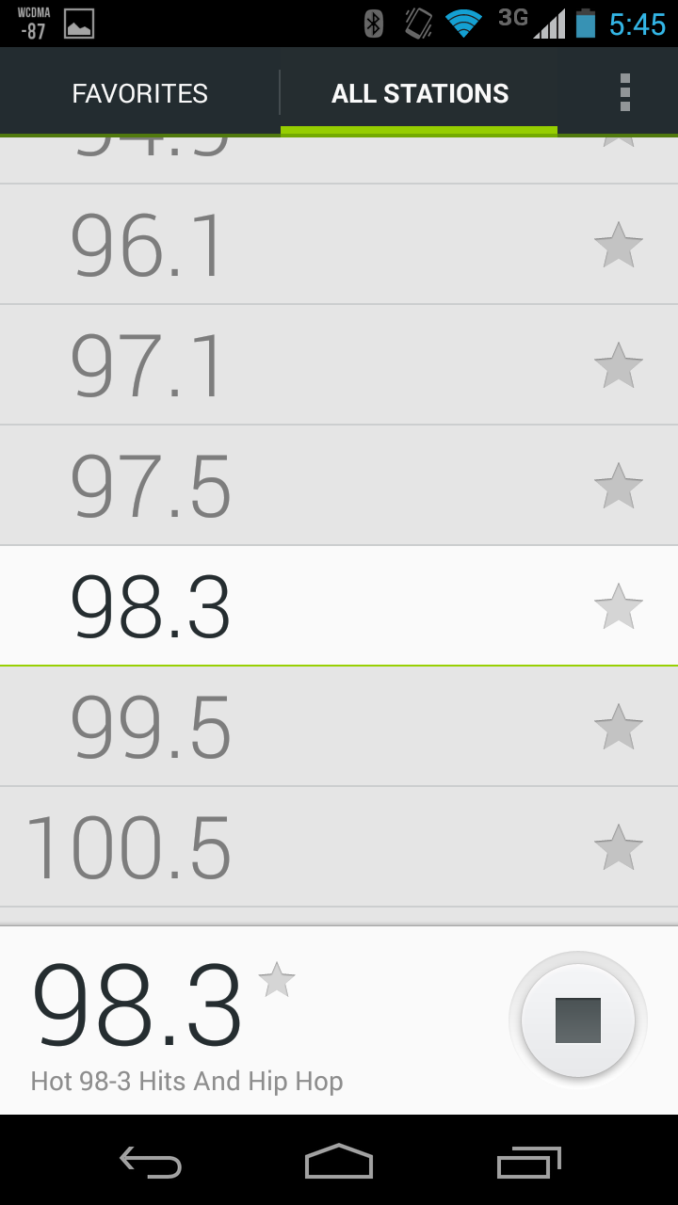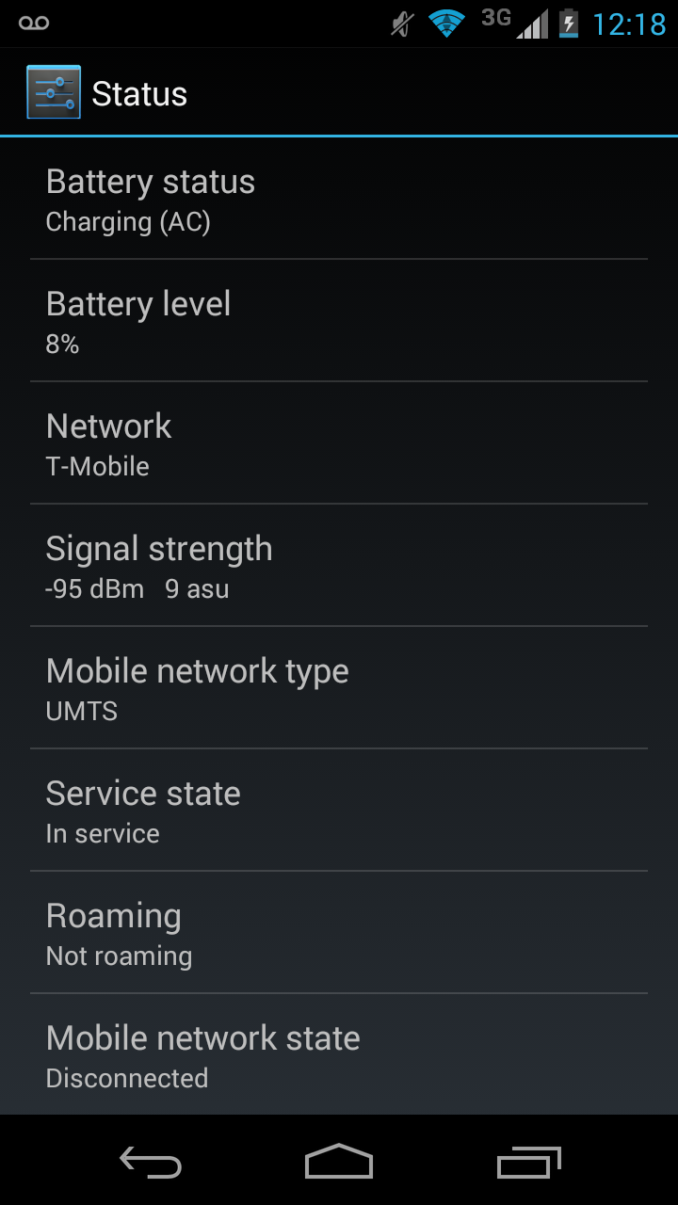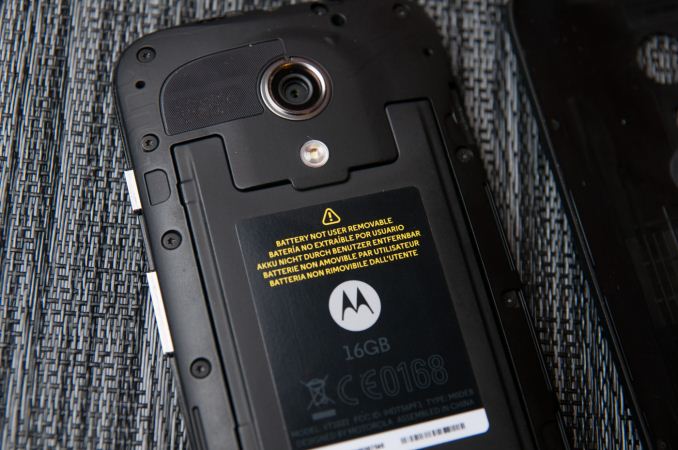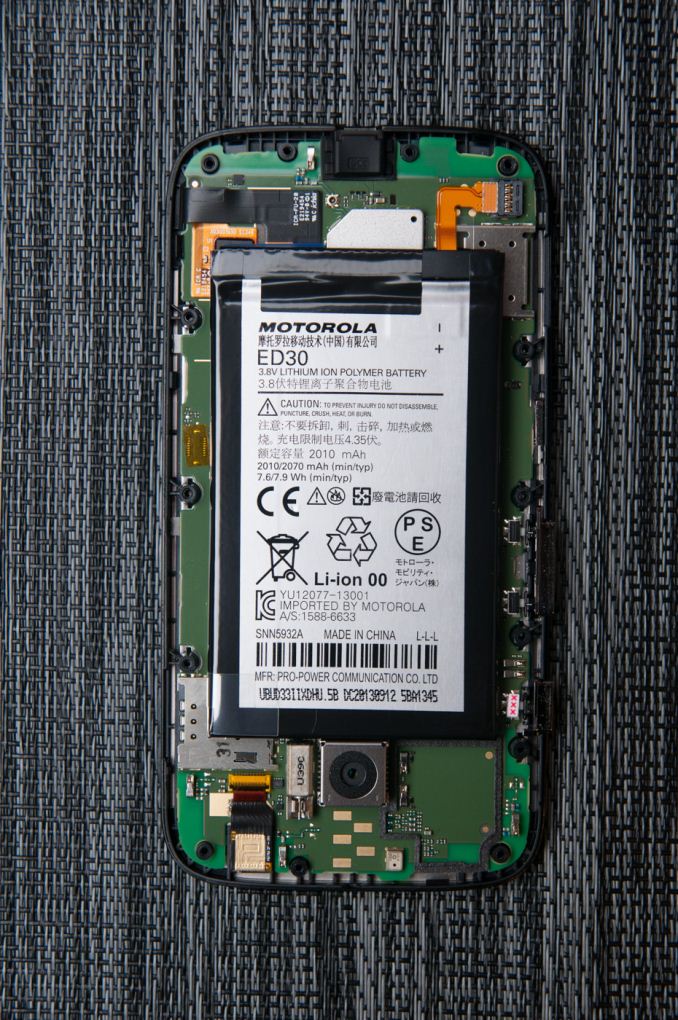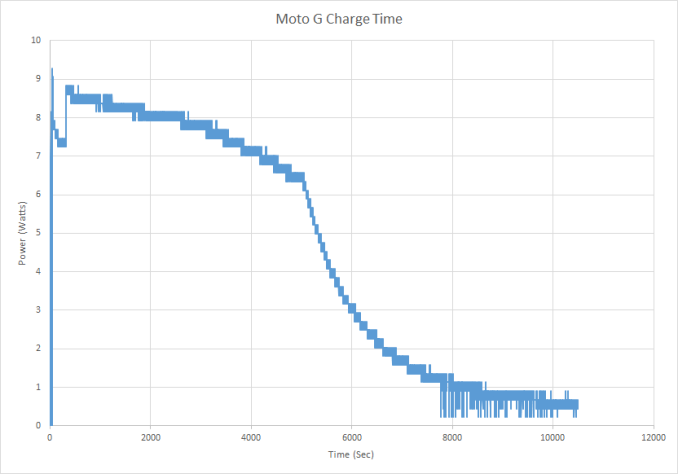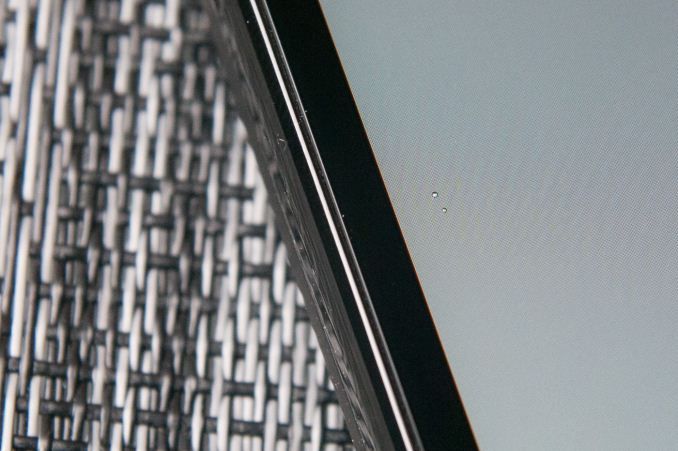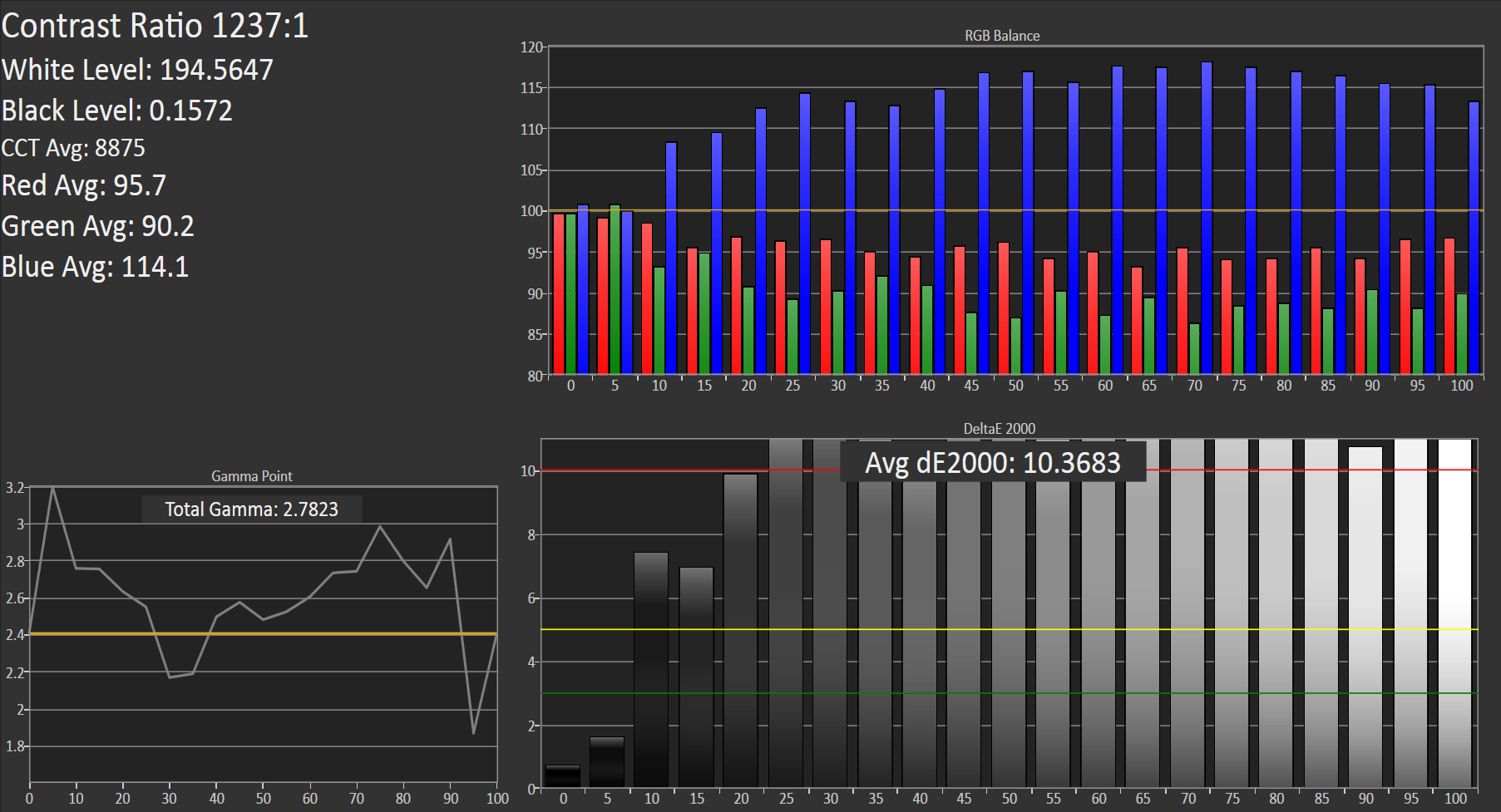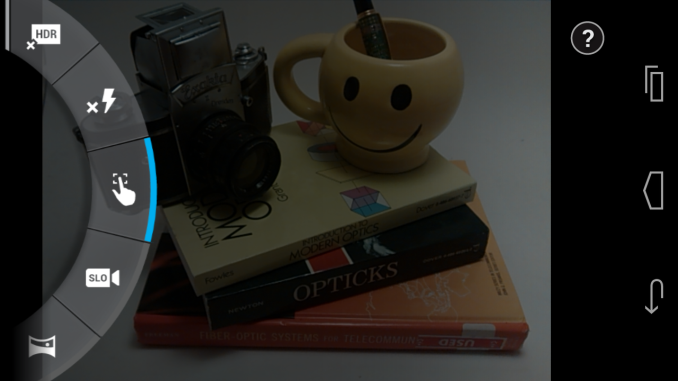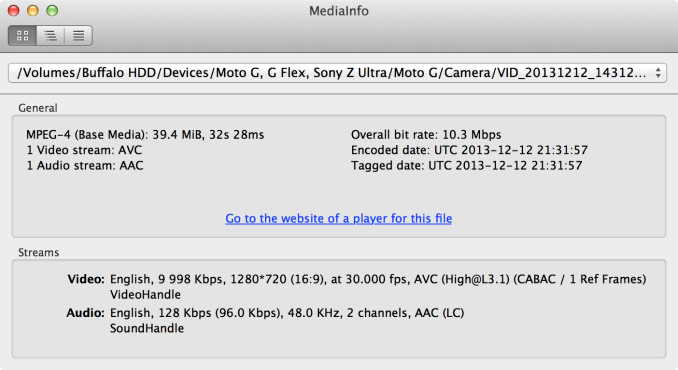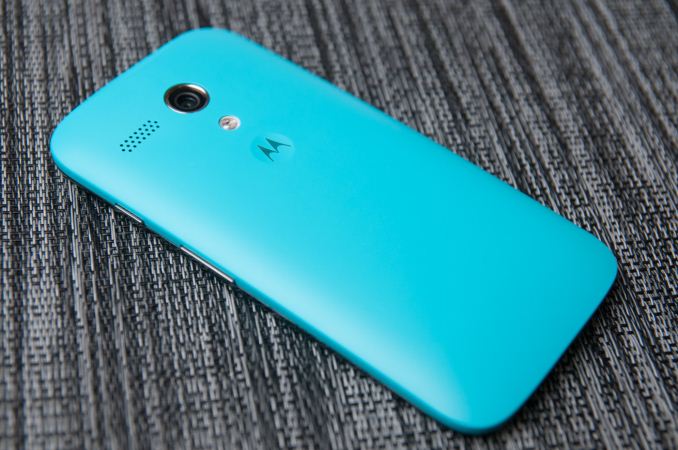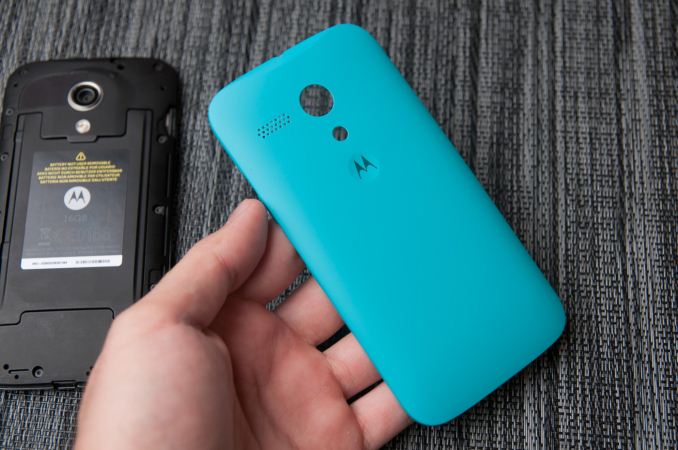
Original Link: https://www.anandtech.com/show/7586/motorola-moto-g-review
Motorola Moto G Review
by Brian Klug on December 18, 2013 2:00 PM EST- Posted in
- Smartphones
- Motorola
- Mobile
- *VA
- Cortex A7
- snapdragon 400
- Moto G
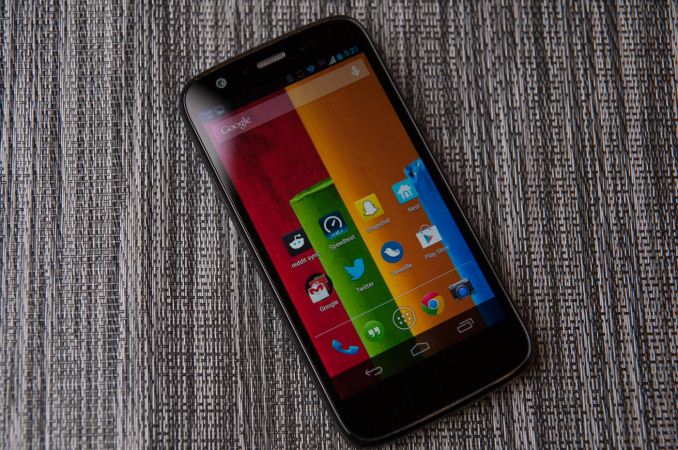
I like what the new Motorola is doing. It seems like an eternity ago, but I remember when phone launches with Motorola meant a variety of variants all with their own idiosyncrasies. Since re-launching itself, Motorola has launched just two new lines of device – the higher end Moto X, and its mass-market cousin, the Moto G which we’re taking a look at. That’s a bit of a simplification, as Motorola is still selling five Droid-branded handsets, but it’s a huge consolidation that’s much easier to follow.
The Moto G’s goal is pretty simple – to deliver an affordable smartphone experience that doesn’t make any sacrifices in something close to the Moto X’s form factor. It’s an ambitious goal that goes right after some of the largest growth segments for smartphones internationally. There’s a ton of competition at the top, it’s somewhere in the middle that’s arguably more interesting right now.
G is a popular character right now, LG was arguably first to lay claim to it with its Optimus G, G Pro, G2, and now G Flex brands, so it’s kind of interesting to see Motorola also lay claim to G with the Moto G. Absent any guidance what G actually stands for, I’m going to take a nod from lens reviewer Ken Rockwell and say that G stands for “Gelded” since the Moto G is really a pared down Moto X, but I wouldn’t attach any real negative connotation to the word. The form factor is largely the same, where the Moto G moves down a notch versus the X is in its camera, display size and tech, cellular connectivity, size (it’s slightly bigger), and of course the lack of active display or always on voice activation features. Like any product, it’s just a different set of tradeoffs, this time more optimized for cost.
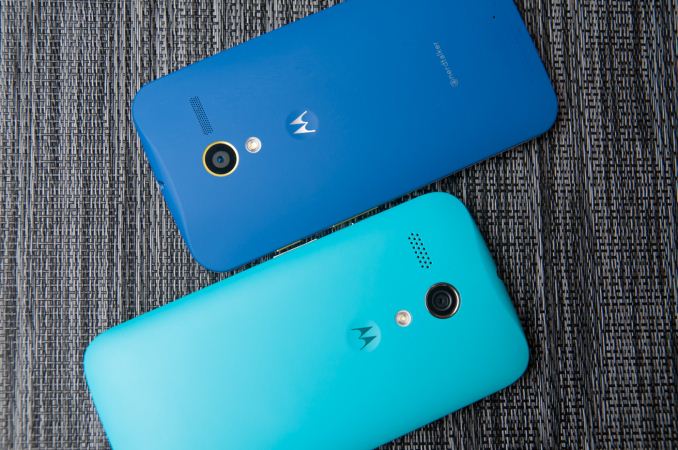
My T-Mobile Motomaker Moto X (top), Moto G with turquoise back shell
Before I started working on the Moto G, I switched back to the Moto X for a while to refresh my comparison point, right after it got the 4.4 update. Motorola let me build a blue with yellow accents Moto X from Motomaker since I recently switched to T-Mobile and my previous device was locked to AT&T. The comparison point helped me really feel out the physical differences between the Moto X and Moto G. You can tell that the Moto G is slightly thicker almost immediately, the changes in width, height, and mass don’t really stick out as much. I can’t put my finger on it but the curve of the G seems slightly less pronounced as well, although the G is still comfortable to hold. I won’t bore you any further, but the dimensional differences really aren’t that noticeable between the two, I don’t feel like the Moto G’s in hand feel is a regression at all versus the excellent Moto X.
| Moto X | Moto G | |
| SoC |
Qualcomm Snapdragon S4 Pro (MSM8960Pro) 2x Krait 300 at 1.7 GHz Adreno 320 at 400 MHz Motorola X8 System (SoC+NLP Processor+Contextual Processor) |
Qualcomm Snapdragon 400 (MSM8x26) 4x ARM Cortex A7 at 1.2 GHz Adreno 305 at 450 MHz |
| Display | 4.7-inch AMOLED (RGB) 1280x720 | 4.5-inch LCD (RGB) 1280x720 |
| RAM | 2GB LPDDR2 | 1 GB LPDDR2 |
| WiFi | 802.11a/b/g/n/ac, BT 4.0 | 802.11b/g/n, BT 4.0 |
| Storage | 16 GB standard, 32 GB online, 2 years 50 GB Google Drive | 8/16 GB, 2 years 50 GB Google Drive |
| I/O | microUSB 2.0, 3.5mm headphone, NFC, Miracast | microUSB 2.0, 3.5mm headphone |
| OS | Android 4.4 | Android 4.3, 4.4 Early 2014 |
| Battery | 2200 mAh, 3.8V, 8.36 Whr | 2070 mAh, 3.8V, 7.9 Whr |
| Size / Mass | 65.3 x 129.3 x 5.6-10.4 mm, 130 grams | 65.9 x 129.9 x 6.0-11.6 mm, 143 grams |
| Camera |
10 MP Clear Pixel (RGBC) with 1.4µm pixels Rear Facing 2 MP 1080p Front Facing |
5 MP w/AF, LED Flash 1.3 MP front facing |
| Price | $199 (16 GB), $249 (32 GB) on 2 year contract | $179 (8 GB), $199 (16 GB) no contract |
If you’ve held the Moto X, the Moto G is immediately familiar. For those that haven’t, the two share what’s probably the best balance of size and form factor among Android handsets right now – Moto G is just a bit thicker around the waist.
On the front the Moto G eschews the “magic” fused glass-plastic top layer. For those unaware, one of the standout features of the Moto X was this seamless (well, relatively seamless) transition from glass to plastic along the edge, which really did make it more comfortable to use. Moto G uses the more pragmatic lip and sunken glass approach, and the sample I was provided has a bit of a gap between the two where dust can gather and show. Not a big deal but worth noting as one of the few visible differences. The Moto G still does have some nice lips that prop the display up so you can lay it display-first on a flat surface without worrying about scratching the display.
The Moto G uses the same button and port placement as the Moto X, which I won’t go over. The buttons feel nice and solid as well, not cheap and flimsy. The speakerphone grille moves to the opposite side, but camera and flash positions remain unchanged. The motorola logo and accompanying dimple also don’t go away.
Impressively, Moto G also doesn’t eschew dual microphones for in-call background noise cancelation. There’s a primary microphone at the bottom, and secondary up top. Moto X had a bottom front, bottom back, top side arrangement, so technically Moto G has one fewer microphone, but having dual mic noise suppression is a noteworthy feature at this price point.
The most dramatic change between the two of course is the removable back door, which doesn’t work so much as a door for the battery as it does gate access to the microSIM slot and add an opportunity for adding a touch of customization with a colored or flip shell. As an aside, it’s odd to me that the Moto X embraced nanoSIM (4FF) yet the Moto G that launches after it goes with microSIM (3FF). It’s possible some of the operators or markets Motorola has in mind for the Moto G haven’t yet made nanoSIMs readily available. There’s a big sticker on the back noting that the battery isn’t replaceable, I’m reminded of the Droid 4 which also included a removable back and a big sticker, but no removable battery.
Motorola sent a turquoise colored snap-on shell in addition to a blue flip shell to check out on the Moto G. By default the phone comes with a black shell, but there are six different color shells you can choose from, in those two (flip and non-flip) varieties. I appreciate how much even something like this helps differentiate the Moto G versus competition that comes in at best maybe two or three colors. The materials, fit, and finish on the two snap covers I was sent seem excellent. I have no complaints, there’s no creaks or gaps to speak of. Shells run $14.99, flip shells cost a twenty bucks more at $34.99.
The flip cover nails it though, there’s a magnet inside to both keep the cover shut and in place when closed, and another ostensibly for signaling open and closed status – Moto G turns on automatically when opened, and shuts off when closed. Those two features should be requisite for anyone even thinking of bundling a flip cover as a first party accessory at this point, and I’m impressed to see them on this device at that price point.
Inside the relatively small Moto G box you don’t get much in the way of extra stuff. There’s no bundled USB wall charger or pack-in headphones, just a USB cable. I’m awash with USB chargers so I don’t mind OEMs saving the extra few dollars by not including an extra one, in the case of Moto G at least that savings seems to actually get passed on to the customer. I’ll talk about it in the charging section but Moto G seems well behaved with a variety of USB power sources, thankfully.
Moto G doesn’t try to push industrial design somewhere crazy, and obviously at the price point that it’s coming in at, it can’t really afford to. Solid execution which doesn’t deviate a lot from Moto X and good overall construction are the real highlights.
Motorola has embraced relatively stock Android since the launch of Moto X. I originally disliked how the Moto X wasn’t really stock, (cue the philosophical discussion about what stock really means), but truth be told the software preload is devoid of what I don’t like about the skinned, operator-adulterated stuff we’d get otherwise. It strikes perhaps the optimal balance between the two, what works is left intact, what tweaks there are seem to be the bare minimum to appease operators and make the experience better for the majority of users.
The Moto G doesn’t deviate from that formula. At launch, the Moto G comes running Android 4.3, the latest possible version supplied by Qualcomm for the platform inside.
Motorola has promised an update to Android 4.4 KitKat in January (probably near the end of the month), this aligns with the software roadmaps I’ve caught glimpses of. Remember that Motorola is still effectively an OEM and subject to the software release cadences of its silicon suppliers.
The Moto G’s unlocked and operator-free status makes it subject to a bit less than the operator-attached variants of the Moto X I’ve played with, like the AT&T address book and status indicator branding. On the Moto G there’s none of that, just the few tweaks that Motorola has added in, like Device ID, Assist, Migrate, Care, and of course their own camera application.
The delta between the Moto X and G on the software front really comes down to subtraction of features it lacks the hardware for. Specifically the Active Display notifications and interface which used a TI MSP430 and leveraged an AMOLED display, and the always-on voice activation (“OK Google Now”) which used a TI C55x DSP. It’s an easy to understand differentiation point between the two products that I can’t complain about, and although I enjoyed those two features, their absence doesn’t really dilute the software choices that make the Moto G enjoyable.
Moto G also adds an FM radio over Moto X. Inclusion of FM radio is something which remains oddly is absent from most flagship handsets, but a must have on the lower end devices.
Just like the Moto X, the bulk of these applications (Camera, FM radio, Boot Services) are updatable over the Play Store. Motorola has effectively decoupled a bunch of their own first party applications from the normal OTA process.
Again I can’t complain about Motorola’s software strategy for the Moto G. I almost hesitate to make the comparison, but Nexus ends up making flagships that are very competitive on cost in the high end segment, the space Moto G is competing in is entirely different. Having Android 4.3 and the promised upgrade to 4.4 within essentially a month is great, but real proof of Motorola’s commitment will be in continued software support beyond that update.
Battery onboard mobile devices remains one of the biggest concerns for shoppers, and even in a mass market device like the Moto G it’s an important axis. Although Moto G has a removable back door, the battery isn’t designed to be user accessible and is sealed inside, there’s a sticker which pretty much explains the situation.
Inside, the Moto G has a 2070 mAh, 3.8V battery for a capacity of 7.9 watt hours. It loses the stacked 3D structure that was a highlight feature of the Moto X, but still is a relatively large battery for a device with a 4.5 inch LCD display.
To evaluate battery life we turn to our battery life testing suite, which we run over WiFi and all the cellular interfaces appropriate for the device. Here we see a good combination of regular spikes in CPU usage with idle time, hopefully simulating constant, reasonably paced usage. As always the display is set to exactly 200 nits and configured the same way we always configure devices for maximum consistency.
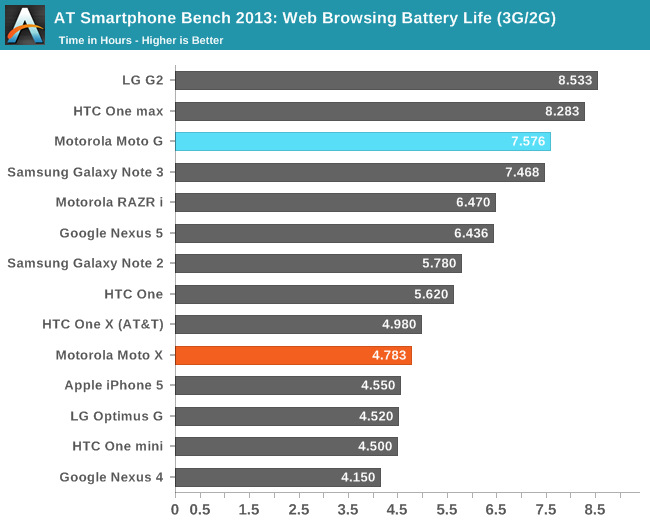
The Moto G starts out with an impressive result on 3G. There’s no LTE on the Moto G so we’re only looking at the subset of devices that I’ve tested on 3G with the new battery life test. Still it’s impressive that the Moto G can crank out just over 7.5 hours on here, considerably more than Moto X forced onto 3G.
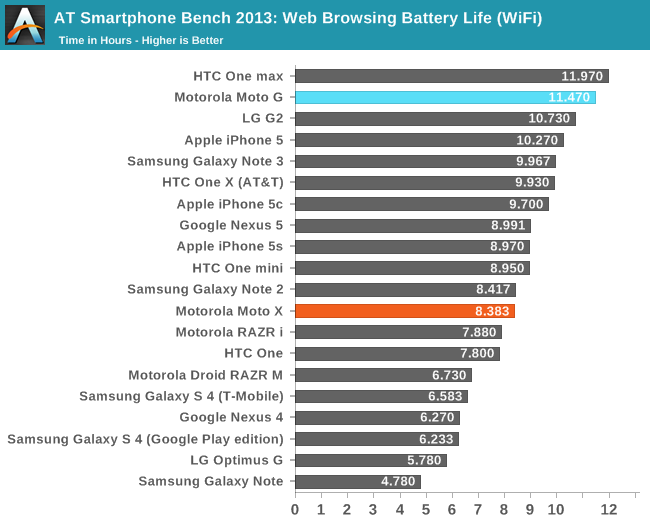
The WiFi test opens up considerable more comparison points, and here I’m really impressed by what the Moto G is able to crank out.
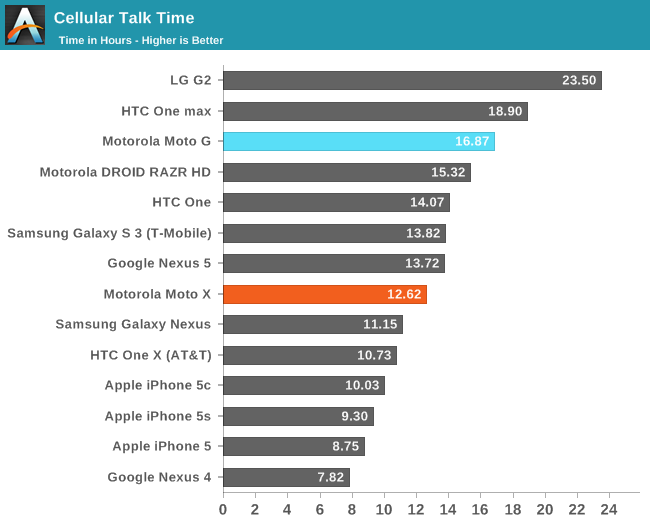
Cellular talk time is self explanatory, and again the Moto G winds up with an impressive result. I remember when Motorola seemed to somehow always be able to dominate the call test, Moto G definitely reminds me of those days.
Compared to the Moto X, the WiFi and 3G battery life tests really wind up being a story of the power consumption tradeoffs between LCD and AMOLED that remain to this day. The display size to battery capacity ratio is pretty big with the Moto G, and of course there are further improvements to overall efficiency with the latest Qualcomm silicon and modem block inside.
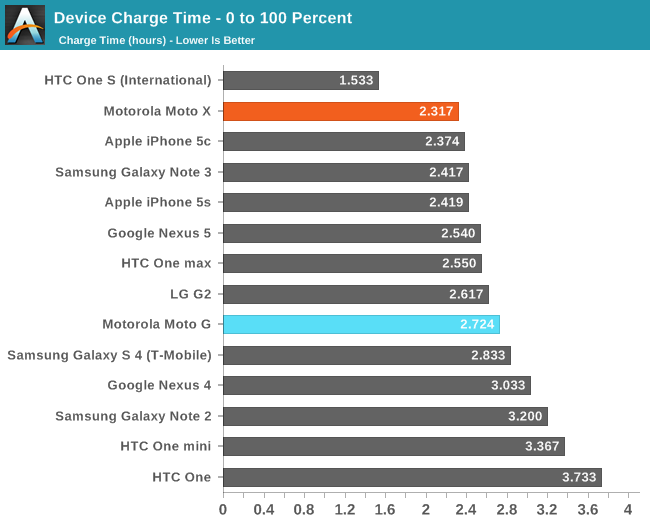
I mentioned that the Moto G doesn’t come with a charger in the box, a choice which cuts down on cost and is starting to make a lot of sense give the ubiquity of cheap USB chargers.
Thankfully Moto G seems to be good about its charge signaling, as it can pull up to 2 amps on appropriate chargers. The Moto G seems to be compliant with BC 1.2, and seems well behaved with drawing whatever is appropriate from other chargers as well.
At the heart of Moto G is a new Snapdragon 400 SoC that it’s our first time seeing, specifically MSM8226. MSM8226 consists of four ARM Cortex A7 cores clocked at between 300 MHz and 1.2 GHz, and the same Adreno 305 GPU as the former S400 variants clocked at up to 450 MHz. There’s a single channel 533 MHz LPDDR2 memory interface feeding the SoC, and video encode/decode specced for 1080p30 video. All of this is built on TSMC’s 28nm LP process, not 28HPM like the newer S800 tiered SoCs from Qualcomm.
For some, Qualcomm using an ARM core and not a Krait or Scorpion might seem odd, however Qualcomm has used straight ARM cores like the Cortex A5 for some time in its lower end SoCs and as an optional AP its modems for offloading tasks like routing or driving a web interface. MSM8x26 is our first time looking at their new A7 based S400 lineup, and succeeds the MSM8x30 series which was based on dual core Krait 200 (MSM8x30) and 300 CPUs (MSM8x30AB).
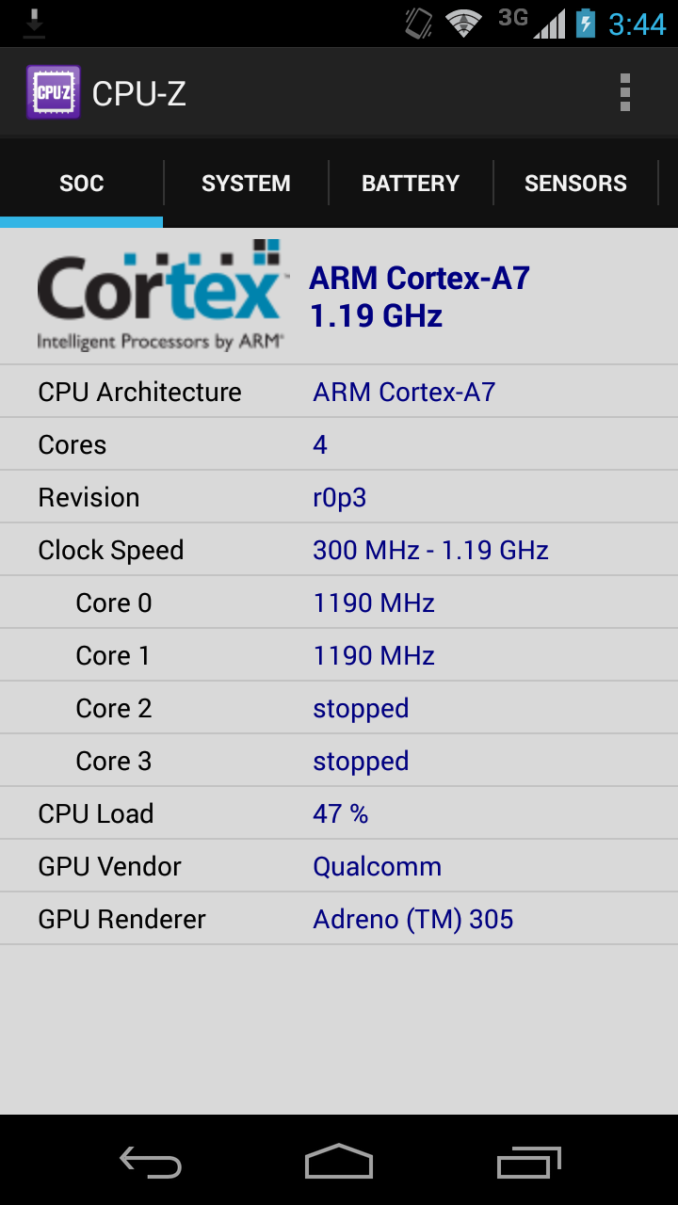
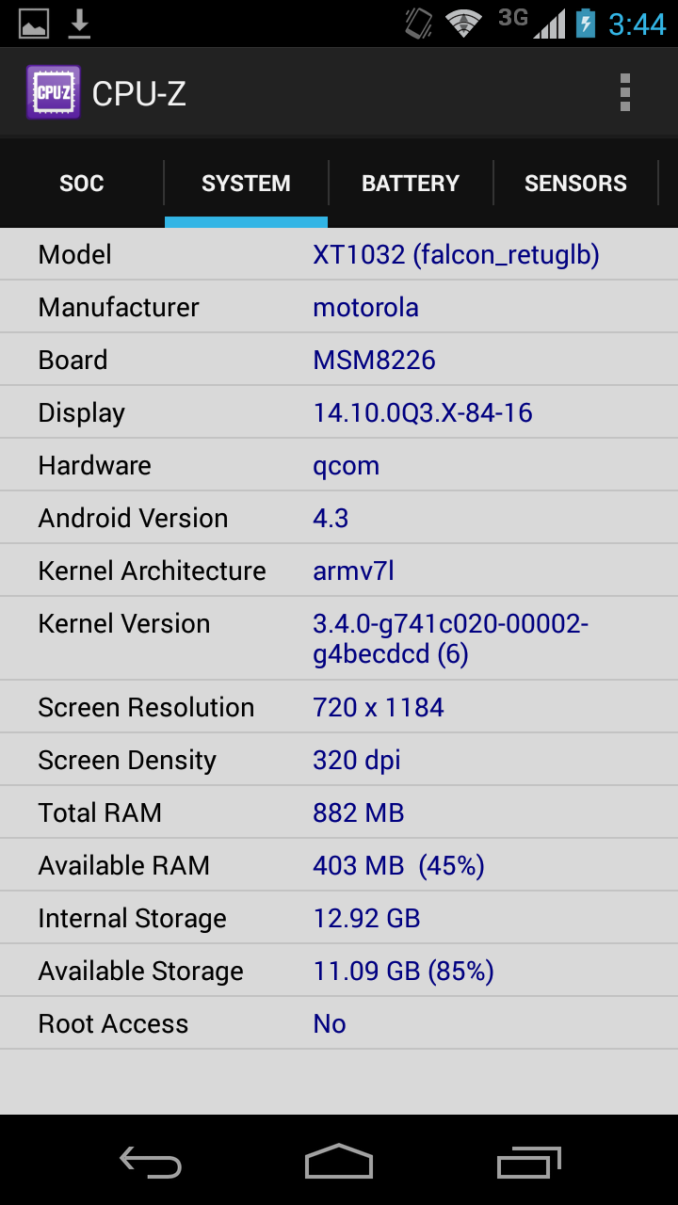
CPU-Z for Android needs an update (8226 on Moto G)
Anand has previously gone over some of the architectural details for the Cortex A7 CPU, which is an in-order core with an 8 stage integer pipeline capable of dual-issuing integer instructions, but not floating point, NEON, or some others. ARM’s goals for A7 seem to have been keeping die size small and integer performance close to a Cortex A8, while maintaining complete ISA compatibility with Cortex A15 for big.LITTLE. The ARM Cortex A7 CPUs in 8x26 are r0p3 revision, and there’s 1 MB of L2 cache, the maximum configurable option for Cortex A7. At 1.2 GHz the CPU clocks are basically at ARM’s recommended point, although I suspect we’ll see a similar S400 tier part with slightly higher clocked A7s.
My previous experience on a similarly tiered Qualcomm SoC was the MSM8930 with dual Kraits inside the HTC One mini, which was adequate for most things but definitely struggled when multitasking and jumping between applications. For the most part, I’m surprised at how much faster MSM8x26 feels in the Moto G with quad A7s. Storage I/O being decent no doubt helps a lot of the multitasking experience along, but even stuff like browsing in Chrome seems much better than I remember. The only real thing gating experience is memory footprint, as apps and background processes definitely get suspended more often than on the flagships I usually carry with 2 GB of RAM, it’ll be very interesting to see how the Moto G fares with the 4.4 KitKat update running on its 1 GB of LPDDR2.
| I Can't Believe I Still Have To Update This Table | |||||||||||
| Device | SoC | Cheats In | |||||||||
| 3DM | AnTuTu | AndEBench | Basemark X | Geekbench 3 | GFXB 2.7 | Vellamo | |||||
| ASUS Padfone Infinity | Qualcomm Snapdragon 800 | N | Y | N | N | N | N | Y | |||
| HTC One | Qualcomm Snapdragon 600 | Y | Y | N | N | N | Y | Y | |||
| HTC One mini | Qualcomm Snapdragon 400 | Y | Y | N | N | N | Y | Y | |||
| HTC One max | Qualcomm Snapdragon 600 | Y | Y | N | N | N | Y | Y | |||
| LG G2 | Qualcomm Snapdragon 800 | N | Y | N | N | N | N | Y | |||
| Moto RAZR i | Intel Atom Z2460 | N | N | N | N | N | N | N | |||
| Moto X | Qualcomm Snapdragon S4 Pro | N | N | N | N | N | N | N | |||
| Moto G | Qualcomm Snapdragon 400 | N | N | N | N | N | N | N | |||
| Nexus 4 | Qualcomm APQ8064 | N | N | N | N | N | N | N | |||
| Nexus 5 | Qualcomm MSM8974 | N | N | N | N | N | N | N | |||
| Nexus 7 | Qualcomm Snapdragon 600 | N | N | N | N | N | N | N | |||
| Samsung Galaxy S 4 | Qualcomm Snapdragon 600 | N | Y | Y | N | N | N | Y | |||
| Samsung Galaxy Note 3 | Qualcomm Snapdragon 800 | Y | Y | Y | Y | Y | N | Y | |||
| Samsung Galaxy Tab 3 10.1 | Intel Atom Z2560 | N | Y | Y | N | N | N | N | |||
| Samsung Galaxy Note 10.1 (2014 Edition) | Samsung Exynos 5420 | Y(1.4) | Y(1.4) | Y(1.4) | Y(1.4) | Y(1.4) | N | Y(1.9) | |||
| NVIDIA Shield | Tegra 4 | N | N | N | N | N | N | N | |||
Motorola continues to not participate in the benchmark boost or performance mode shenanigans that we’ve been keeping track of. My proverbial hat is off to Motorola for erring on the right side of the benchmark boost situation once again, and Moto G doesn’t change anything in that regard, CPU doesn’t plug in at maximum frequency upon launching any apps I can find.
In addition, MSM8x26 seems to have a relatively modest thermal budget, which isn’t surprising. I haven’t yet seen the SoC throttle down CPU clocks, and Moto G doesn’t get very warm to the touch at all. It’s really at the high end that SoCs are already essentially thermally constrained and have steady state performance deltas versus short term performance for a minute or so.
For an objective look at performance, we turn to our usual mix of CPU, GPU, and storage benchmarks. The most interesting comparisons are arguably the other non S600 (Nexus 4, SGS4, HTC One) or S800 (Nexus 5, LG G2, Padfone Infinity) based devices:
Moto X - 1.7 GHz MSM8960 Pro (2x Krait 300 CPU, Adreno 320 GPU)
HTC One mini - 1.4 GHz MSM8930 (2x Krait 200 CPU, Adreno 305 GPU)
CPU Performance
We start with our CPU related benchmarks which consist of a mix of JS benchmarks and a few others. I’m still not pleased with the state of CPU benchmarking on Android, even four years into this foray of characterizing mobile device performance the situation isn’t pretty.
Sunspider was one of the first benchmarks I started running on mobile devices, primarily since the web was (and still is) one of the few places you could test anything cross-platform. There’s now a variety of other JS benchmarks we run on devices (Kraken, Octane, Vellamo HTML5), some which are less of a performance optimization target for vendors than others.
The remainder are CPU tests which aren't JavaScript benchmarks, AndEBench which has a Java (Dalvik) and Native (ARMv7) mode, and the 3Dmark Unlimited Physics test which is really a CPU benchmark at heart.
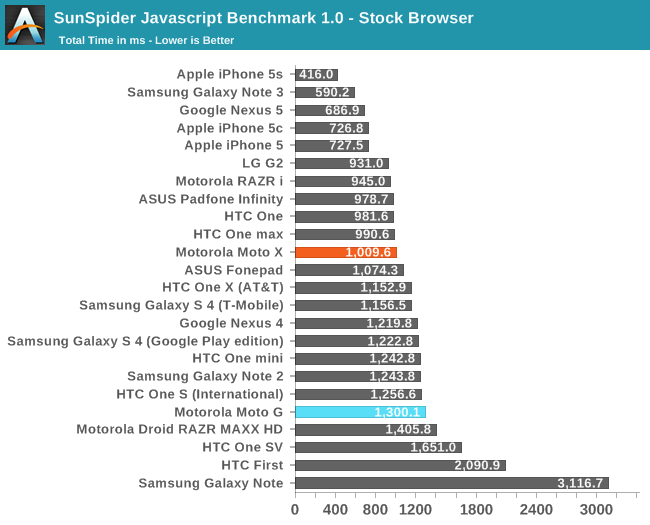
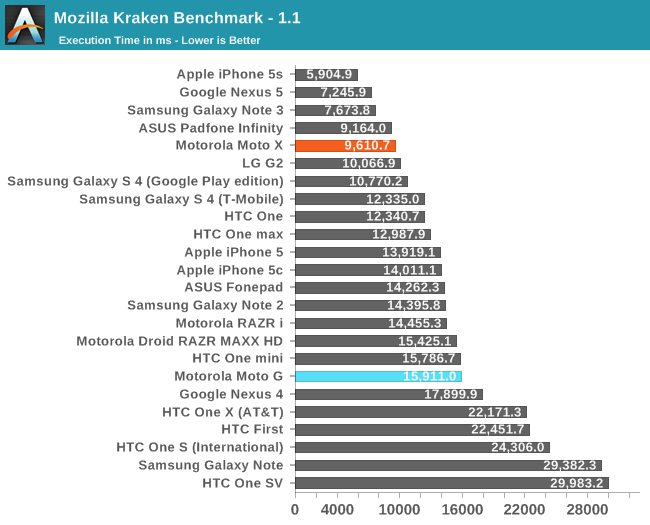
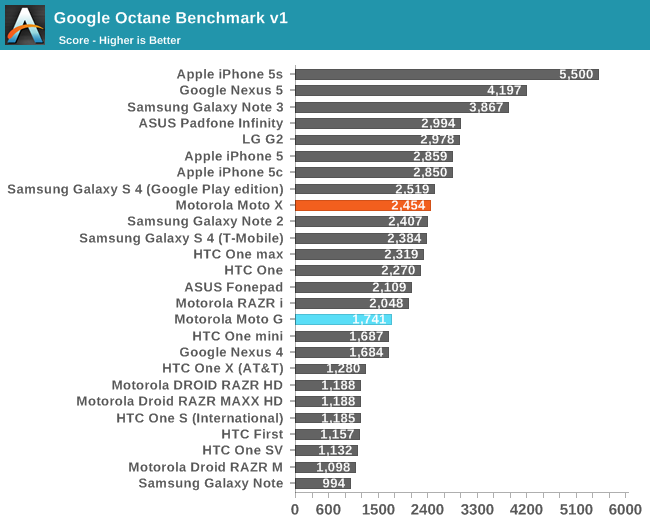
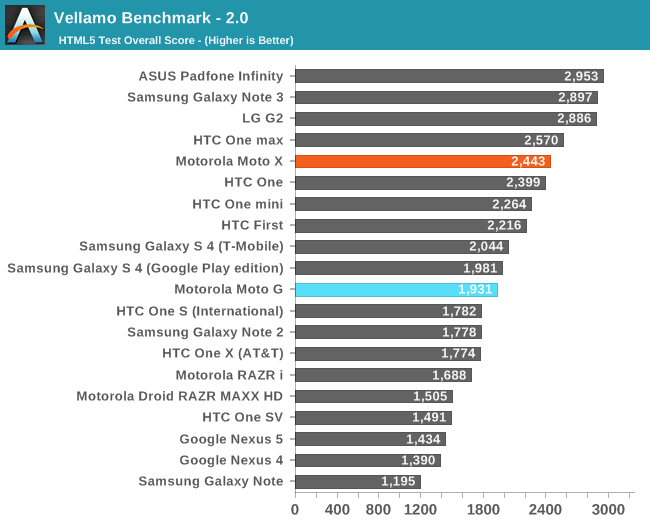
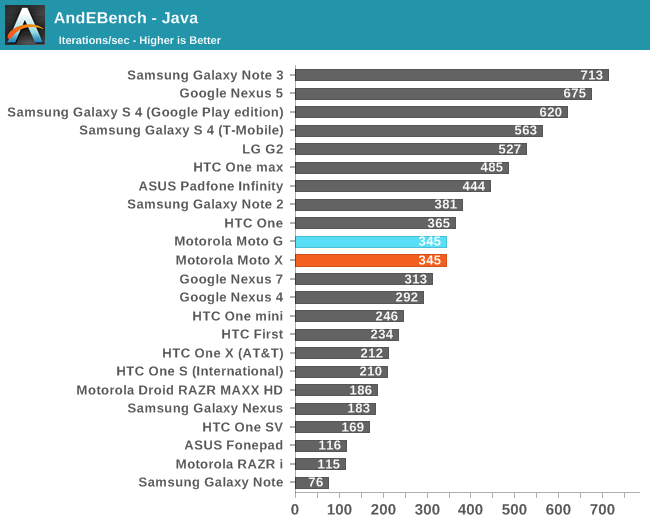
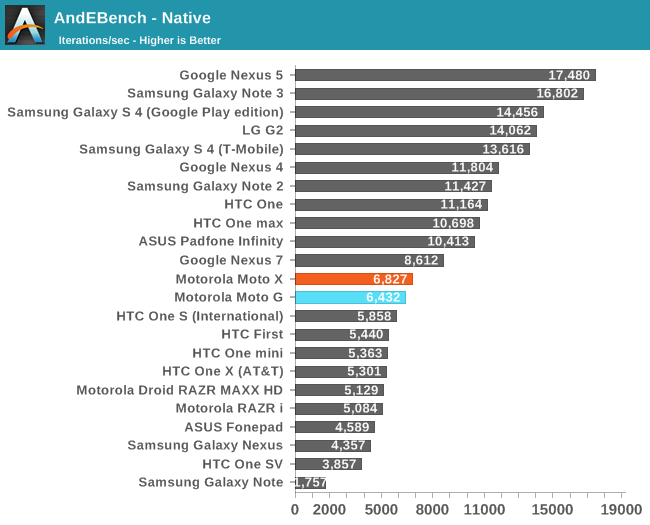
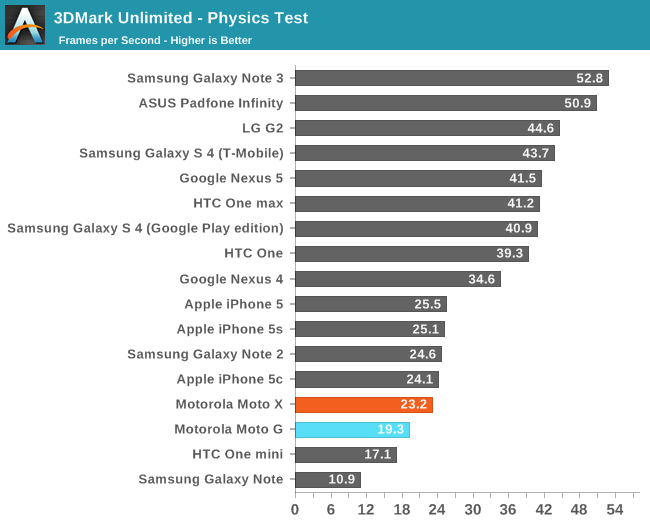
It's interesting to look at the Moto X versus Moto G cases since they're completely differently tiered SoCs, and the Moto X's 8960Pro is a bit north of what was flagship last generation. In that case, there's anywhere between a 20 and 30 percent performance advantage for the Moto X, not huge, but still substantial.
The One mini is again the other interesting data point, here there's performance north of the Moto G in the web based benchmarks, but separation the other way on the other native CPU tests. I'd say this is indicative of how single threaded performance is expectedly greater on Krait 200 than it is Cortex A7, but obviously workloads that can scale to all 4 threads help the platform pull ahead.
GPU Performance
On the graphics side we turn to the usual assortment of 3Dmark, Basemark X, and GFXBench (formerly GLBenchmark 2.7) for comparing performance. At this point we've seen the bulk of the Adreno 3xx family at least once before, and the Moto G uses the same Adreno 305 GPU as 8930 inside the One mini, but at slightly higher 450 MHz clocks (vs 400 MHz). Motorola previously disclosed that Adreno 320 was a "quad core" part quite publicly with their Motorola X8 branding, which makes it easy to speculate about what's inside Adreno 305, although you have to keep in mind that scaling isn't totally linear due to what does get replicated across "cores" and shared memory bandwidth.
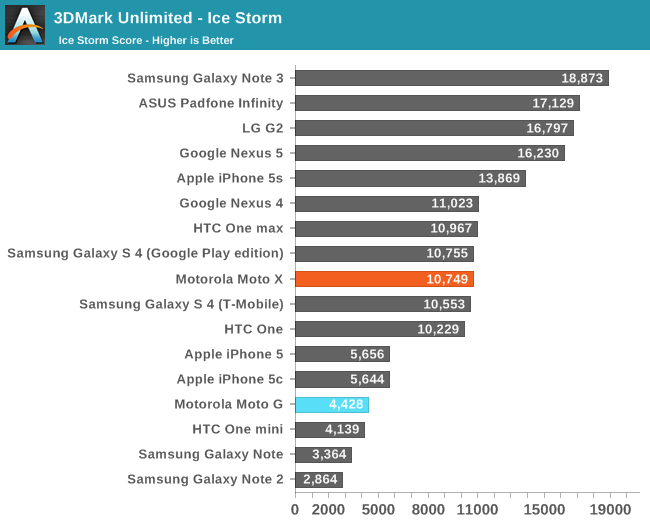
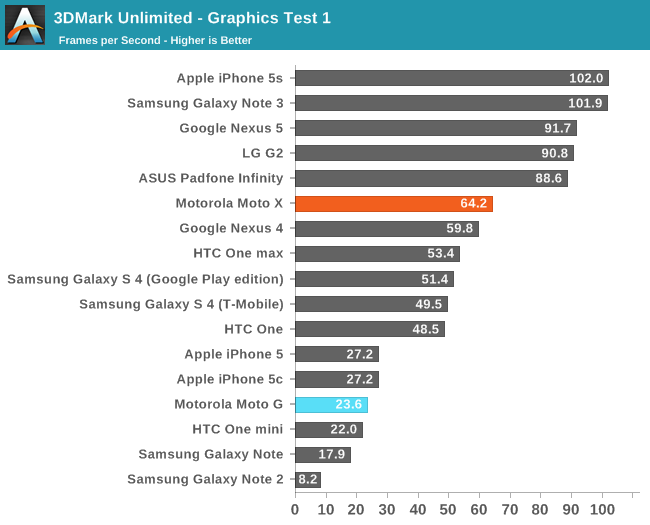
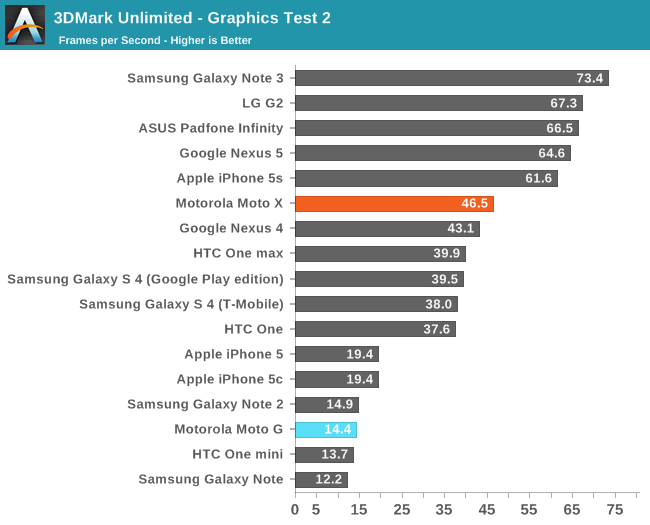
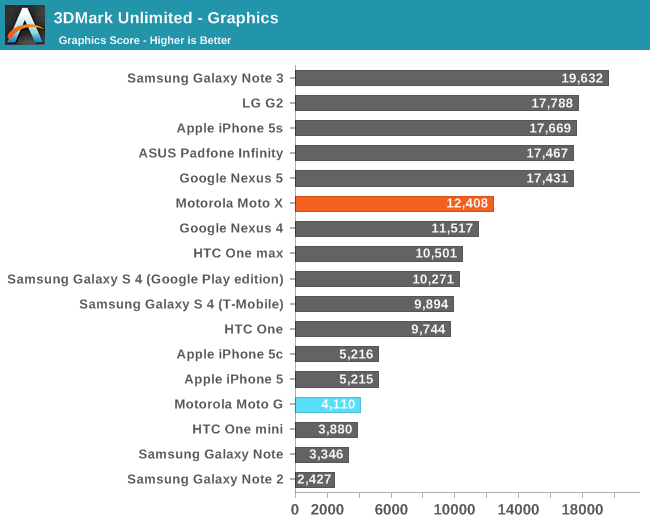
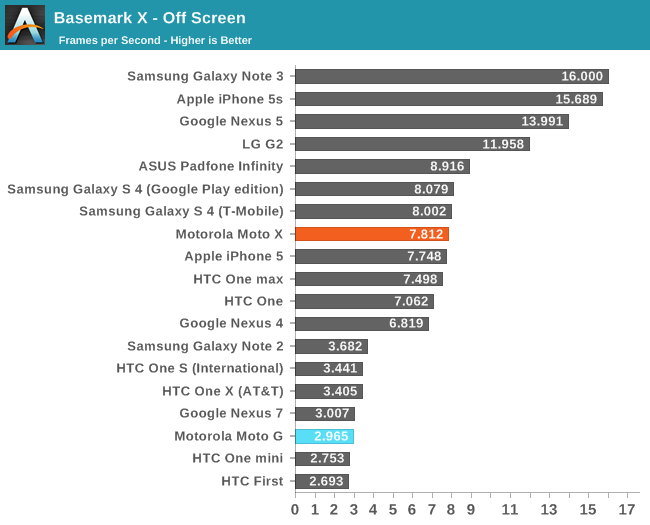
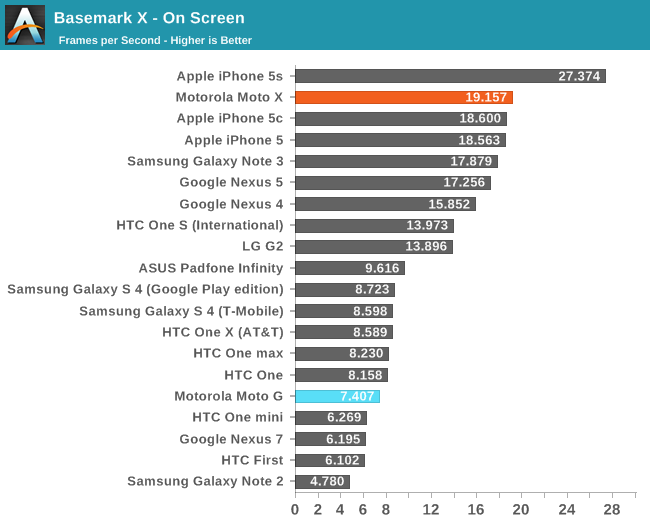
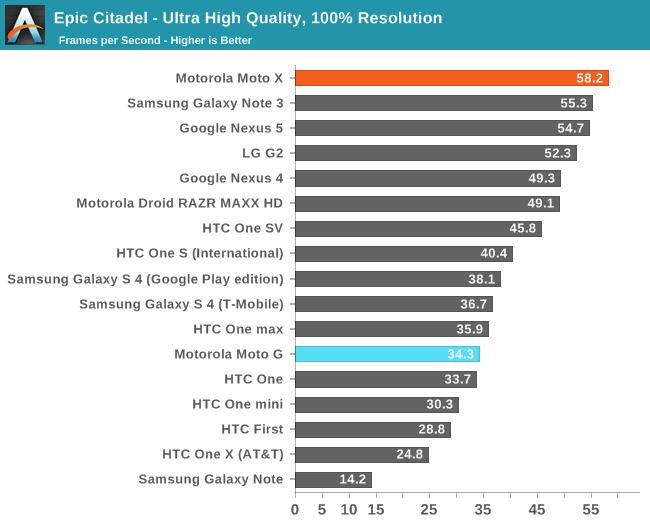
There's a big delta between the Moto X and Moto G here, with Adreno 305 offering around 30 percent of the 320 GPU's performance, depending on the test. There's a substantially bigger delta between the Moto G and the highest end devices. The 50 MHz clock advantage and newer platform help the 8x26 based Moto G also pull ahead of the 8930 based One mini.
Last but not least is GFXBench 2.7 (formerly GLBenchmark) and its associated subtests, which has been a long staple in the 3D graphics section and hopefully doesn’t need much introduction at this point.
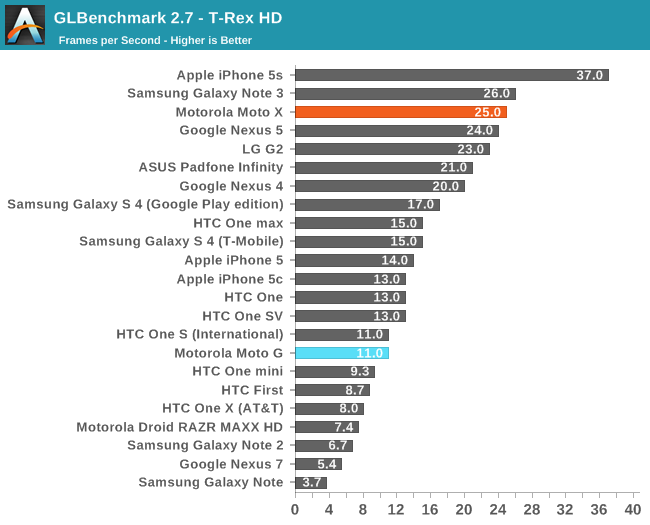
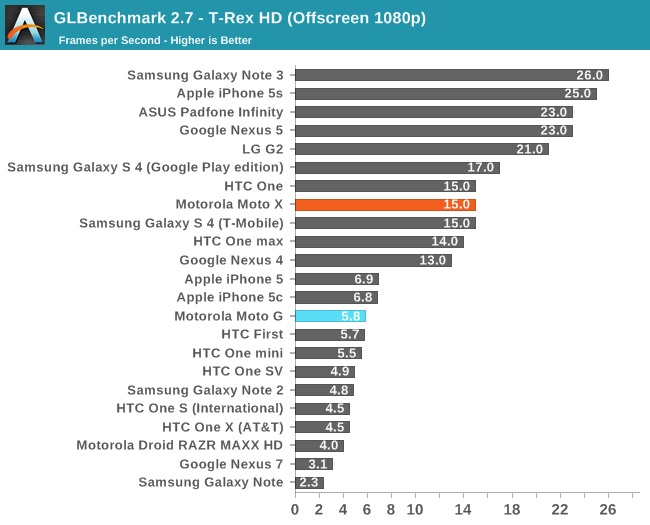
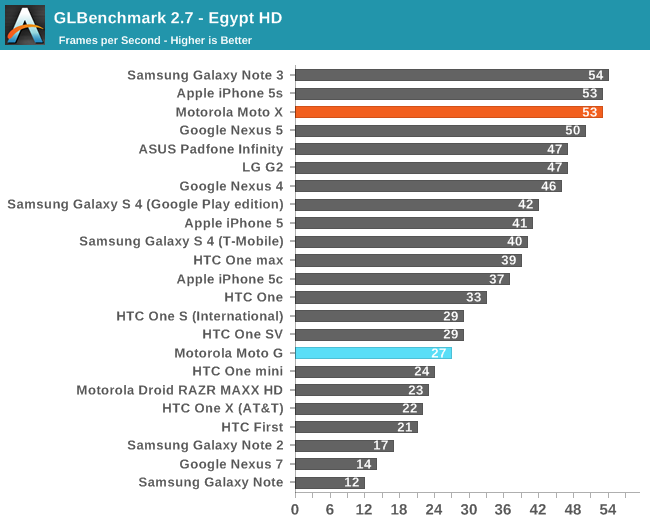
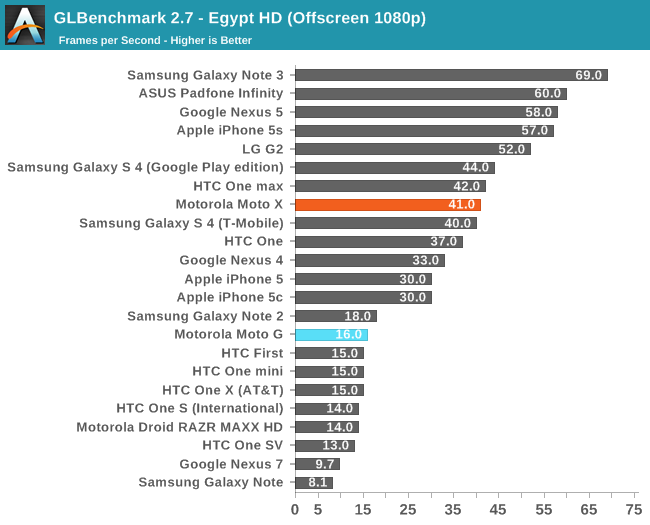
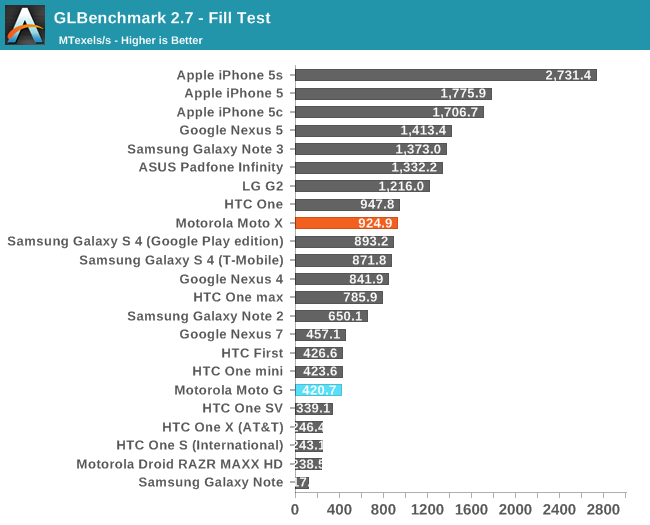
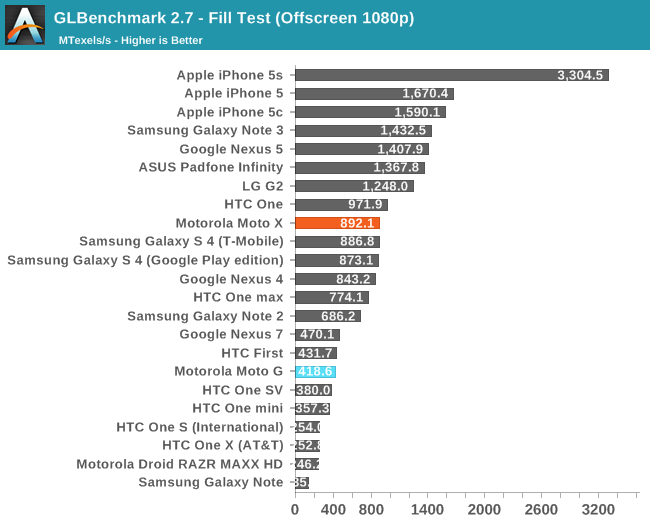
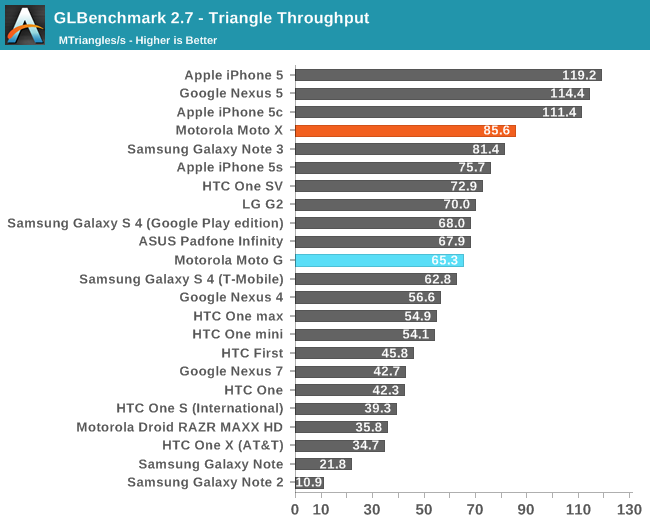
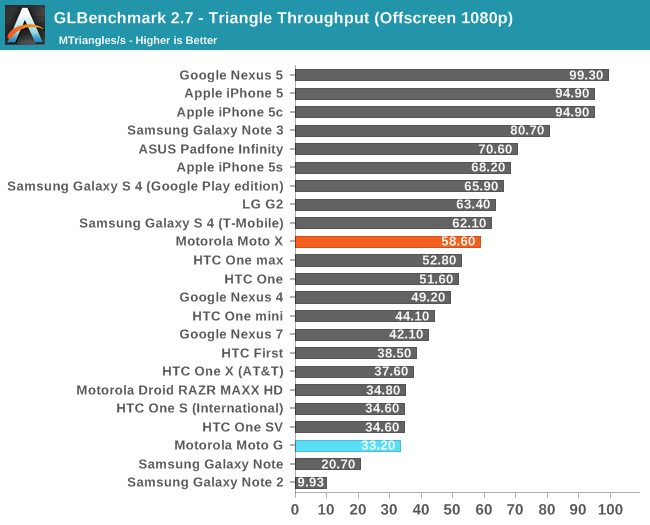
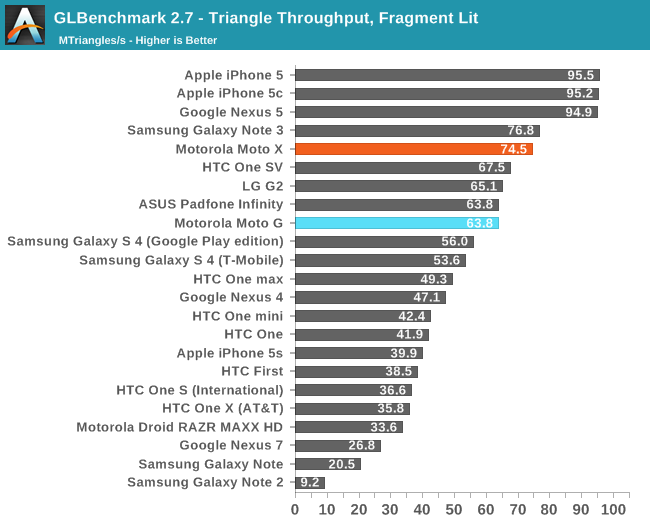
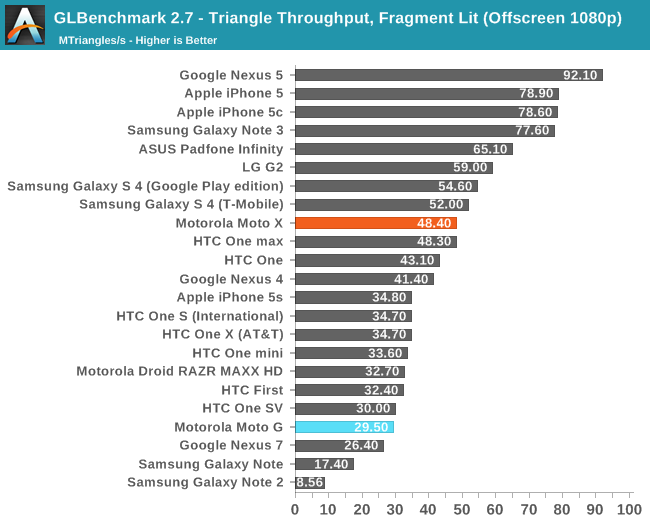
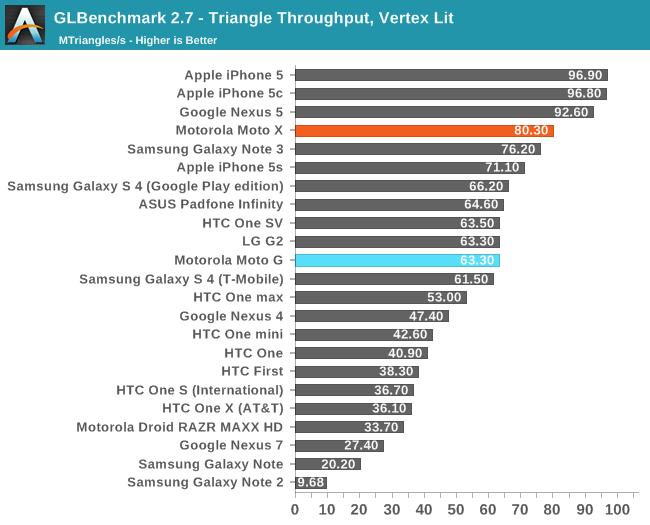
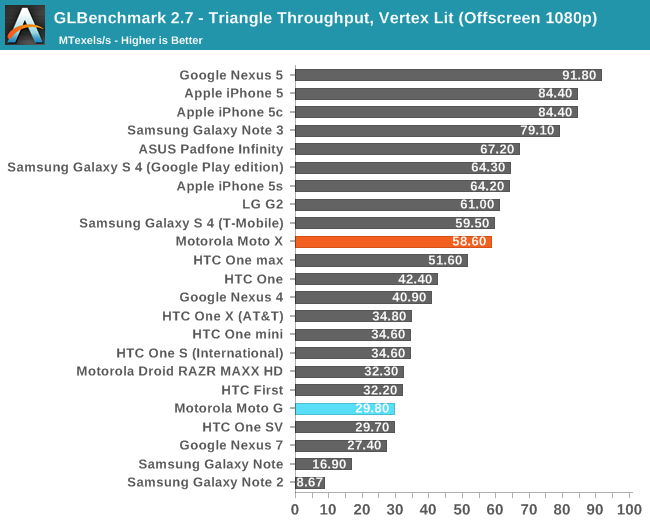
The primarily compute-bound game subtests (Egypt and T-Rex HD) which are part of GFXBench show a slightly bigger delta, with Adreno 305 offering just shy of 40 percent of the performance of the 320.
NAND Performance
Last up is NAND or storage performance. We’ve been tracking storage performance on these devices for a little while now and have noticed forward progress over the generations.
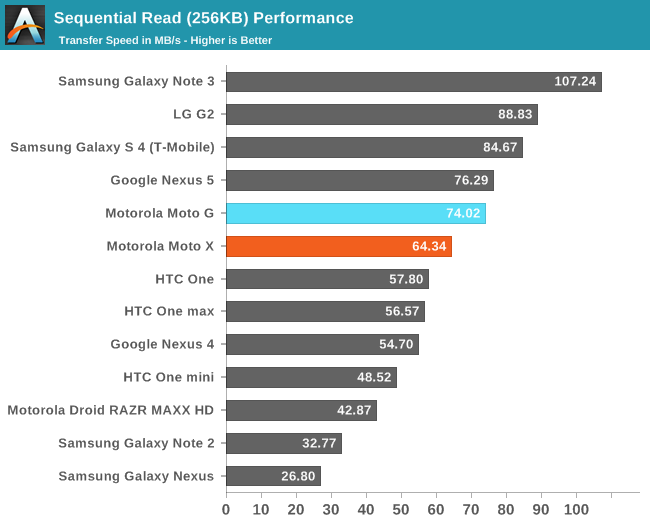
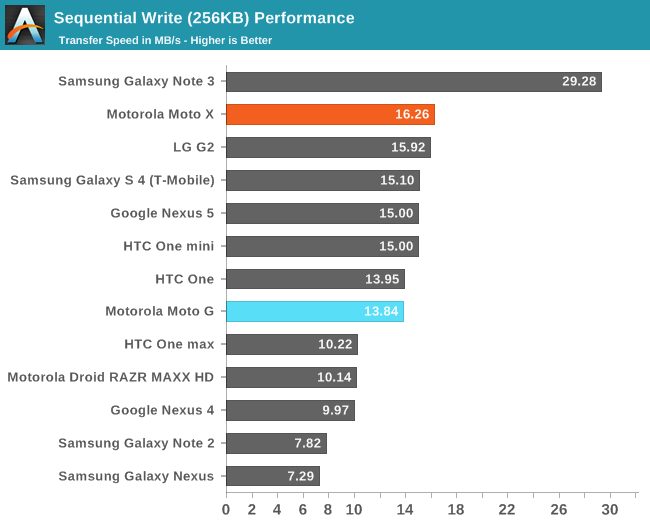
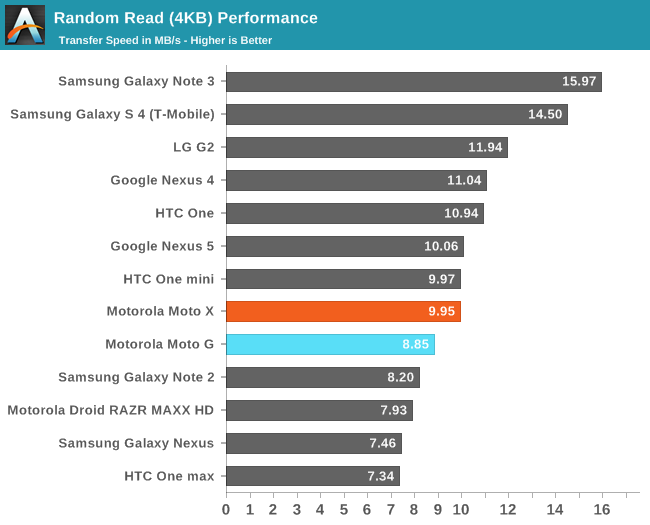
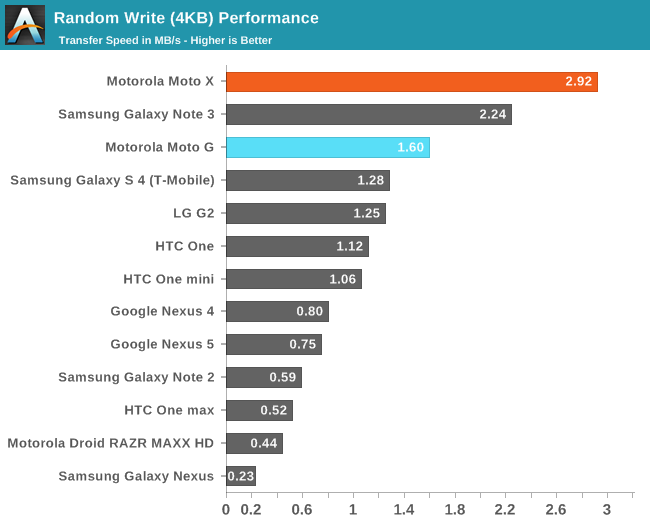
In the case of Moto G, the device continues the use of F2FS (Flash Friendly File System) for the /data mount which began with the Moto X. This helps the device post some impressive numbers and feel speedy when performing I/O heavy tasks in spite of having a pragmatic storage solution. I should note that we were sampled the 16 GB Moto G, not the smaller 8 GB model.
Display on mobile devices is one area where we’ve seen considerable improvement. Pixel density has gone up, contrast ratios have improved, and the emphasis on low power in a platform gated by its battery size means there’s always innovation happening. In the case of the Moto G, what we’re after should really be a display that looks visually appealing without any of the egregious issues that plague most midrange devices – poor viewing angles, low resolution, low contrast, dim displays.
On paper, the Moto G has what would probably have been a flagship display for a mobile device a year or two ago, it’s a 4.5-inch LCD with 1280x720 resolution and 326 PPI pixel density. The comparison point is the Moto X with a 4.7 inch AMOLED panel of the same 720p resolution and 312 PPI pixel density.
I’m pretty impressed with how the Moto G’s display looks. Subjectively, viewing angles are good, there aren’t any of the issues I normally attribute to non-flagship devices either with low pixel density or contrast that fails to please. There’s no light leakage at all from any of the corners.
One unfortunate thing about the Moto G I was sampled however is the presence of two small bubbles in the cover glass. I initially thought these were dust, but inspection with a microscope reveals they are in fact inhomogeneities in the cover glass.
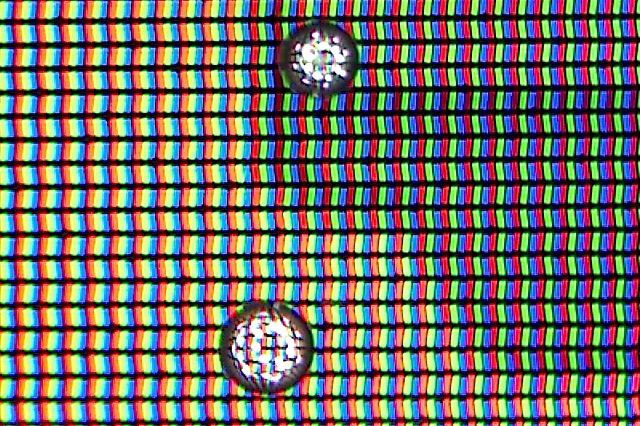
I’m not sure whether these kind of defects are within spec for the Moto G, but they’re distracting and visible on most solid colored UIs or views. I’ve never seen something like this on any handset I’ve reviewed to date.
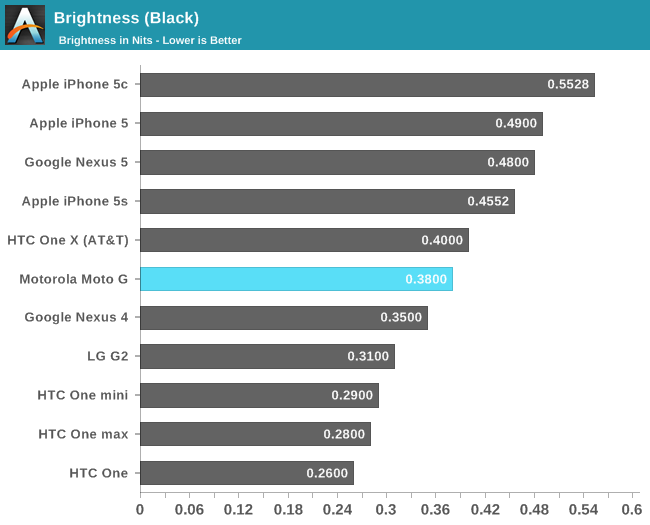
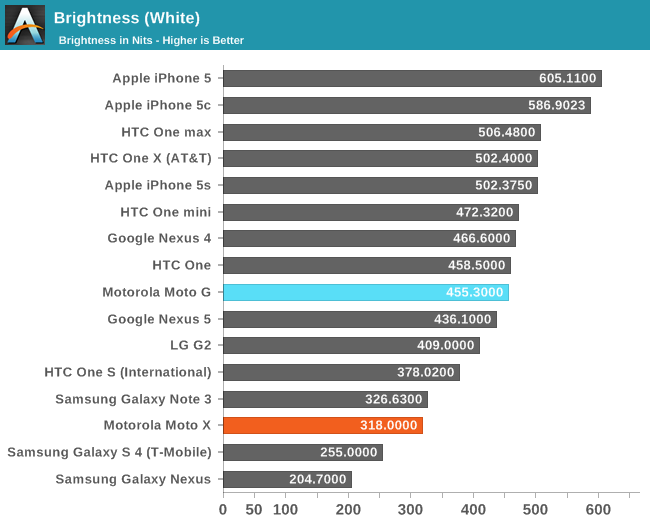
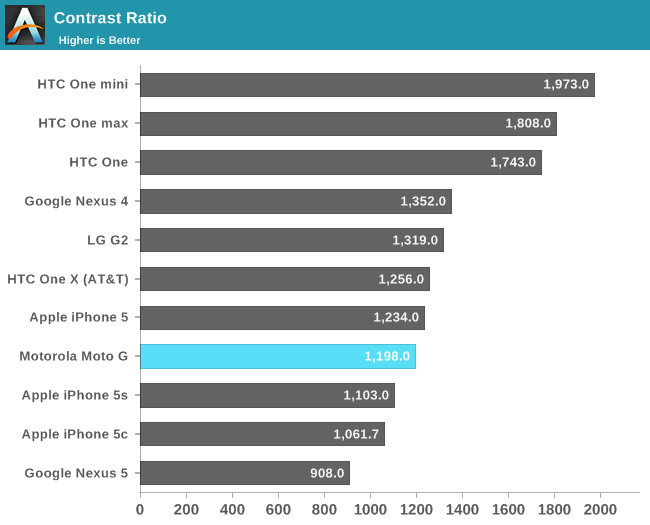
The Moto G goes plenty bright, at just over 455 nits, and delivers contrast numbers that are pretty darn good for the price point at just shy of 1200. Normally black levels are out of control on the lower end devices, I’m not sure if the Moto G uses an IPS panel, but suspect it does.
Upon inspection I immediately noticed that the Moto G display was very, very blue. To measure color accuracy we turn to the same combination of measures that we have used for a while now.
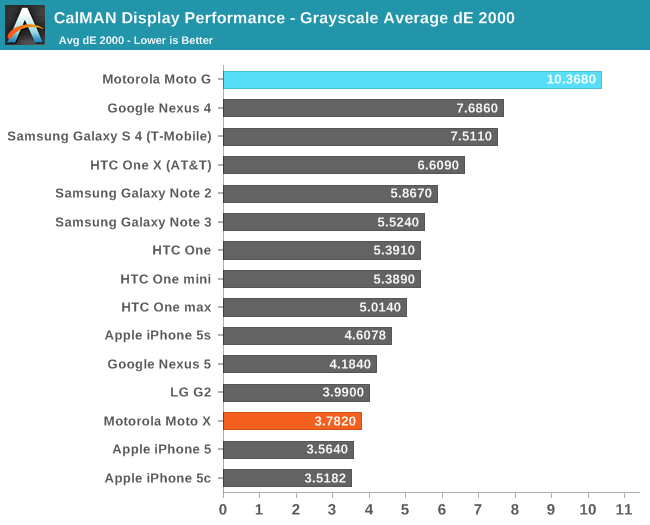
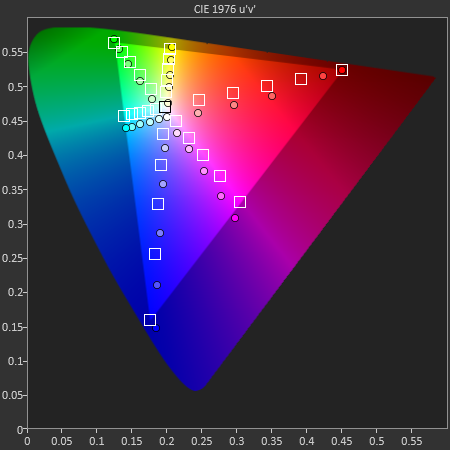
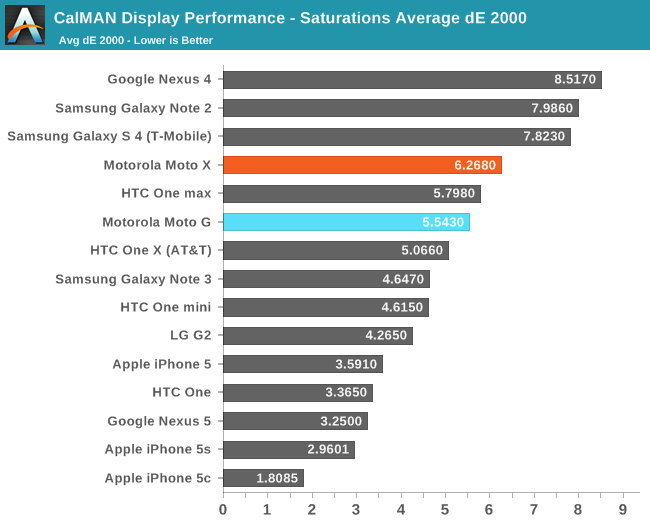
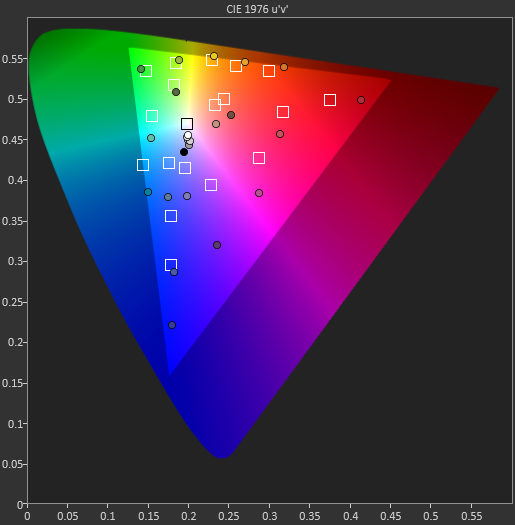
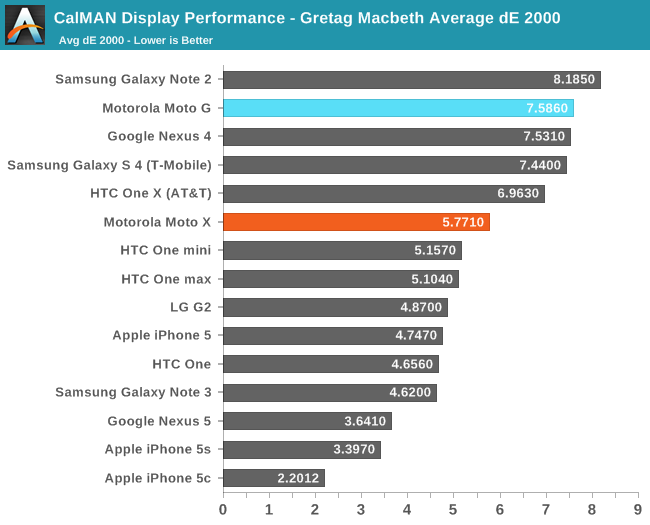
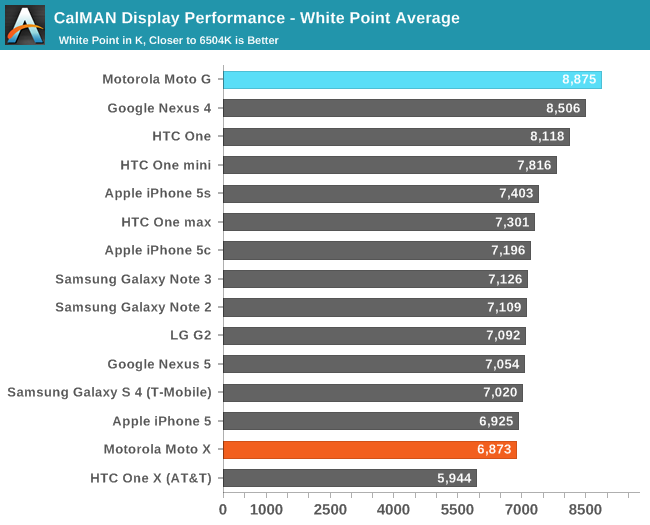
My comparison points are unfortunately primarily high end devices, which makes the Moto G look comparatively poor. The Moto G display tuning is indeed very blue with a white point of nearly 9000K, but I wouldn’t be surprised to learn this is a function of the backlight LEDs used or intrinsic properties of the panel.
Color calibration is something we’ve only just now started to see get taken seriously on the high end devices, if we can’t expect it to be a regular staple there, the midrange is obviously a lost cause. I wouldn’t fault the Moto G for not being very accurate, but it is something to be aware of as a sacrifice at this price point if you’re considering it over a high-end phone. On the flipside, the pixel density and contrast of the Moto G’s display seems excellent given the price, and I suspect the defects in my Moto G’s cover glass are specific to this unit.
On the camera side the Moto G includes a 5 MP rear facing camera with autofocus and LED flash, on the front it includes a 1.3 MP camera. I did some digging and found that the rear facing camera CMOS is an Aptina AR0543 CMOS. There’s nothing on Aptina’s website about the AR0543, but there is an AR0542 which probably is its predecessor with 1/4 Inch format and 1.4 μm pixels. I suspect this is exactly the form factor of the sensor in Moto G, with some slight improvements, I believe the color filter array is Bayer as well, not RGBW like Moto X. The rear facing camera module has a focal length of 3.5 mm which works out to around a 37mm focal length in 35mm-equivalent units, the system has an F/# of 2.4, which is great for a device of this cost.
On the front is the Aptina MT9M114 1.3 MP, 1/6 Inch with 1.9 µm pixels sensor that we’ve seen a lot of in recent days.
Motorola uses the same camera application as the Moto X, and reflects the most recent UI changes that have rolled out in both OTAs and through the Play Store. The biggest change is a new spot focus and exposure point which can be dragged around the live preview. Motorola calls it manual focus and exposure, in practice it’s really a weighted spot meter and focus point that you can drag around. I’d only call what LG has on the G2 or Nokia bundles as manual focus, but the new camera app is a substantial improvement over the UI as it launched with the Moto X, which didn’t afford any exposure or metering controls (instead taking a scene average), only tap to focus, which ran a full AF search wherever you tapped.
The camera settings menu still is a ring chooser that slides out with a drag from the left side, and has settings for HDR, flash, tap to focus/expose, slow motion video, panorama, location, a new aspect ratio toggle (16:9 and 4:3) and shutter sound. The aspect ratio toggle is what’s new versus the X, since the Moto G has a standard 4:3 aspect ratio sensor and not the 16:9 aspect ratio aspect ratio of the Moto X. By default the Moto G launches with the 16:9 aspect ratio for image capture, cropping off part of the image area, but tapping 4:3 gives you a proper live, full field of view, 4:3 preview. Major kudos to Motorola for giving an aspect-correct live preview. Shot to shot latency is longer than Moto X or other flagships, but not inordinately long or on the order of seconds. I should note that the Moto G does not include the same wrist-flick camera activation gesture as the Moto X.
To evaluate image quality we turn to the usual combination of photos taken at the bench locations, although location 7 wasn’t available, and photo tests in a lightbox with lights on, and off, and of test charts. I also continue to take photos while out and about with devices to get samples in a variety of other conditions.
Moto G still image quality is better than I had suspected. Outdoors in well lit scenes the Moto G is totally capable of delivering good quality shots with good exposure and focus.
My only major criticism is that there’s definitely some off-axis loss of sharpness, the leftmost part of almost every image gets blurry quickly, the right side doesn’t show nearly as much. Alignment tolerances for smartphone optics are a part of module cost, I wouldn’t be surprised to see variance like this. In low light or indoors, the Moto G occasionally struggles to produce images without blur, but that’s a complaint I still levy against some modern flagships. There’s also a bit of light leakage on the Moto G which crops up when outdoors, but nothing crazy. Front facing camera quality is totally par with other flagships I’ve tried, which isn’t surprising.
Camera - Video
On the video side, the Moto G’s interface is, no surprise, just like the Moto X. There’s a video button that immediately starts video capture, successive taps in the image area capture still frames from the live video. Although MSM8x26 supports up to 1080p30 video encode for H.264, Moto G oddly enough captures video at 720p30 in H.264 High profile at 10 Mbps. Audio is stereo thankfully at 128 kbps AAC.
As always I’ve uploaded a copy of the video recorded at the usual place to YouTube and to our servers for you to look at without the additional compression.
Video from the Moto G is well exposed and appears great for being 720p. I would personally miss 1080p, but the Moto G seems great for the resolution it affords. There’s no dropped frames or visible macroblocking, and exposure seems good, again my only desire would be for 1080p resolution.
Cellular
The cellular side of the Moto G is an interesting one, at least for those who have kept constantly abreast of wireless banding configurations and the state of mobile RF. At the high end, pentaband WCDMA is now essentially ubiquitous, with parity LTE banding (given the shared nature of ports on the transceiver) and at least a handful more bands for whatever’s appropriate to the region. There’s no global LTE band combination equivalent to quad band GSM or pentaband WCDMA that has emerged quite yet, but it’s getting there, and in the next generation or two we’ll undoubtedly finally see it come to fruition.
|
Moto G (US GSM) |
Moto G (Global GSM) |
Moto G (CDMA) |
|
| Baseband | MSM8x26 - (Up to HSDPA 21.1 Enabled, EVDO Rev.A for CDMA) | ||
| Transceiver | WTR2605/WFR2600 (?) | ||
| GSM | 850/900/1800/1900 MHz | - | |
| CDMA2000 | BC: 0/1/10 | - | 850, 1900 MHz |
| WCDMA |
850, 1700/2100 (AWS), 1900 MHz (Bands 2, 4, 5) |
850, 900, 1900, 2100 MHz (Bands 1,2,5,8) |
- |
| LTE | - | - | - |
The Moto G however comes in a number of different flavors with different band combinations – there’s US GSM, Global GSM, and CDMA. I also suspect there’s at least one more dual SIM variant that we haven’t seen crop up just yet (Update: Apparently this exists already, XT1033 is the dual SIM variant, thanks @evefavretto). On the back case of Moto G there’s a space whose shape matches the microSIM tray at top, and on the board there’s a shield covering pads that are undoubtedly for a microSIM. Interestingly enough Motorola sampled me the Global GSM variant of the Moto G which lacks Band 4. I’ve been using it on T-Mobile successfully however thanks to the relative ubiquity of the 1900 MHz WCDMA carrier in my market. The US GSM variant of the Moto G trades Band 4 for 1 and 8 (2100 and 900 MHz), two popular bands internationally. I’ve seen Moto G erroneously listed as being a pentaband WCDMA phone, which it unfortunately isn’t.
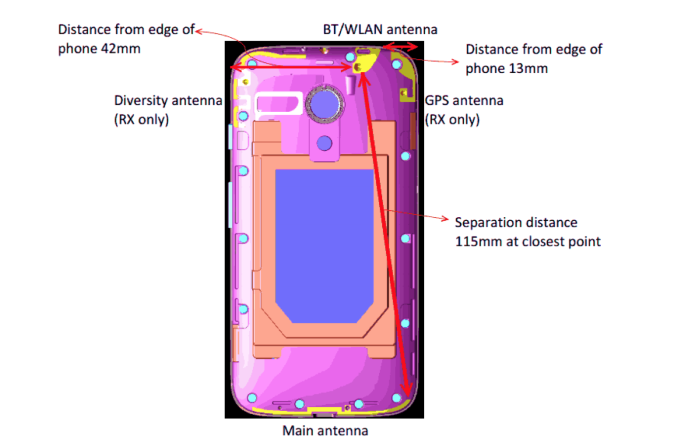
Primary Rx/Tx at bottom, Diversity Rx up top, WLAN/BT, GNSS Rx
Moto G does offer a leg up with receive diversity for CDMA1x/EVDO and HSPA+, something that some HSPA+ flagships from this generation amazingly enough still don’t include. The transceiver is WTR2605 for the primary Rx and Tx ports, and WFR2600 for the additional Rx diversity path. I have no idea what the port configurations look like for WTR2605, but I’d imagine it looks like a cut down WTR1605 of some kind. I have a suspicion that WTR2605 was designed for a quad band UMTS configuration with Bands 1,2,5, and 8, so it might indeed already be port limited in the Global GSM Moto G variant. I also wouldn’t be surprised if there’s some ready made front end module at the front of the whole thing.
Moto G arrives without LTE and instead offers up to single carrier HSPA+ with 64QAM, for up to 21 Mbps on the downlink. Although MSM8x26 itself has a modem block capable of up to dual carrier HSPA+ and category 4 LTE, it seems as though Motorola went for single carrier HSPA+ in the Moto G for time to market reasons, with the LTE and dual-carrier HSPA+ enabled software tree likely slotting in a quarter later than the initial code drop with single carrier HSPA+.
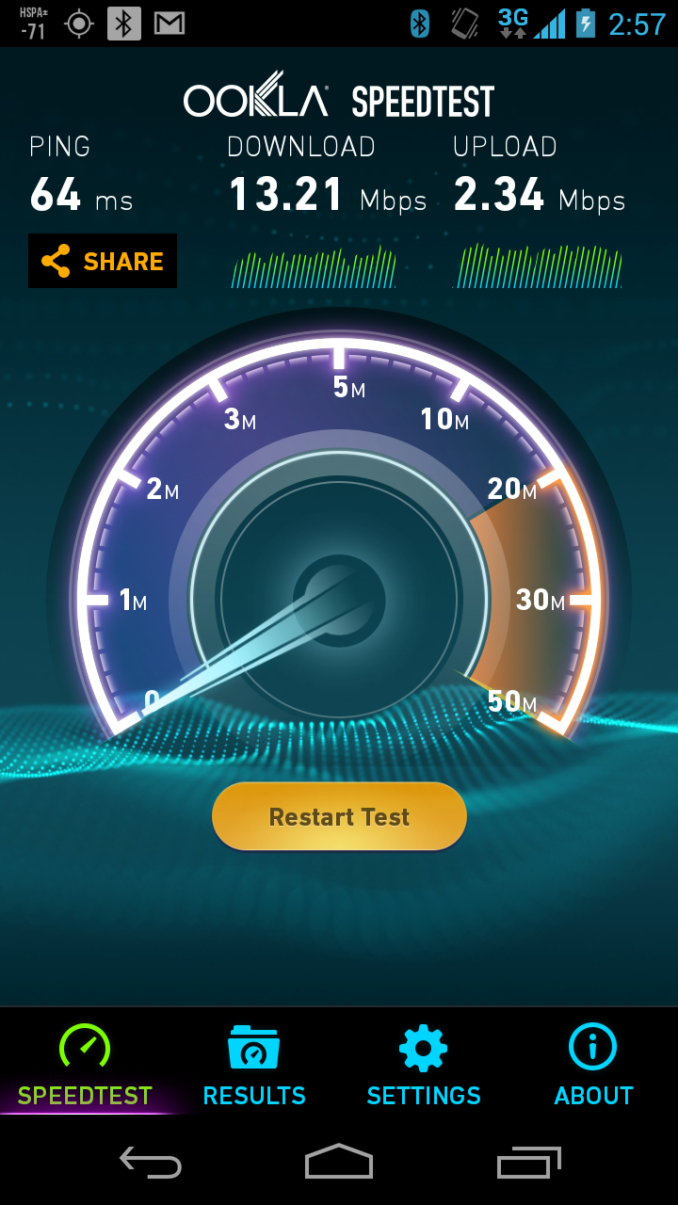
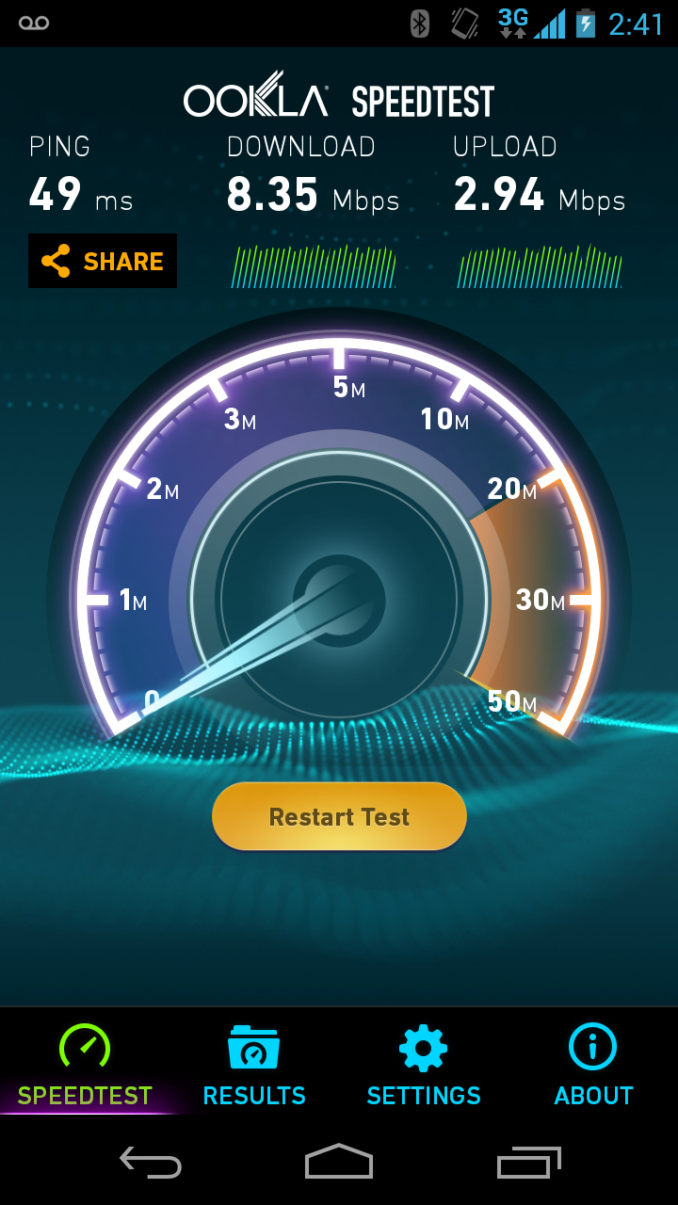
Not bad for single carrier HSPA+ on T-Mobile USA
I’ve been pretty pleased with the cellular performance of the Moto G, even using the variant that lacks Band 4 on T-Mobile USA. Not having LTE made me initially skeptical of it getting operator traction in the US, but it seems as though Motorola has actually had success at least on some prepaid tiers. I’ve been spoiled with LTE devices for a long time now, but single carrier HSPA+ is absolutely still survivable.
WLAN
WiFi connectivity on Moto G is single band 2.4 GHz 802.11n with BT 4.0 and FM receive. On the Moto G, that connectivity is courtesy the new WCN3620 BT/FM/WLAN RF combo chip in a wafer scale package. We’ve now seen WCN3660, the initial dual band combo, then WCN3680 which added 802.11ac, and now WCN3620, the cost reduced version which is single band 802.11n and no doubt offered at a competitive price point with the rest of the platform.
The WLAN/BT stack doesn’t do any antenna sharing and instead has its own transmit and receive path on the top of the Moto G. I don’t have any complaints about WLAN range on the Moto G.
To evaluate performance we turn to the same iPerf test same as always. I was able to attach the Moto G to my network at the 65 Mbps PHY rate that corresponds to long guard interval with a 20 MHz channel.
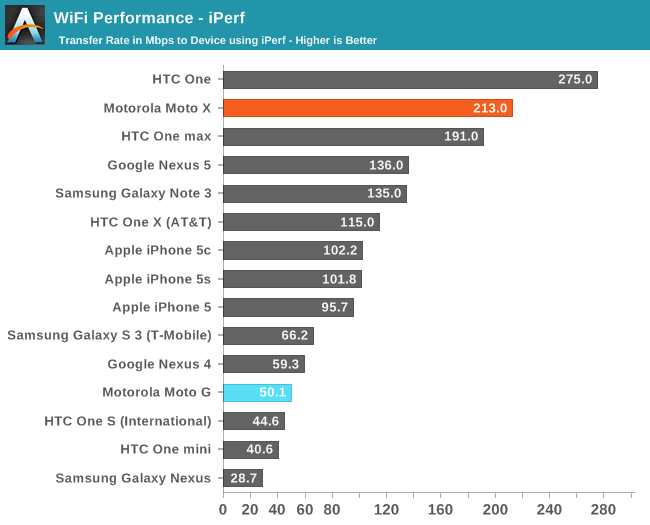
Performance is pretty decent at just over 50 Mbps. It’s a significant delta over the latest devices with dual band 80 MHz 802.11ac support, but again, totally solid relative to the tier it’s in.
Speakerphone and Noise Canceling
Speakerphone on the Moto G seems to be a big chamber if you take the back off, but there’s a relatively small seal against the whole affair, although the grille has larger holes than Moto X’s relatively tiny ones. Loudness is competitive, but unsurprisingly short of Moto X.
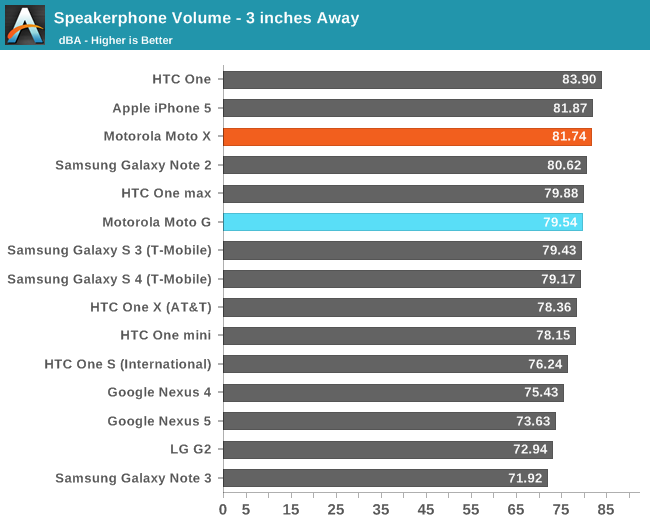
I’d describe Moto G’s speaker as decent, not overly loud or rich sounding.
Dual microphone noise suppression is still a somewhat notable feature at the midrange. In the case of Moto G, Qualcomm’s Fluence package is used in a configuration with the primary microphone at bottom and secondary at very top. I did some digging and also found that Moto G is using Qualcomm’s WCD9302 audio codec which we haven’t seen before, again a more midrange variant. I’ll leave the earphone/line out audio testing for Chris to evaluate.
Noise suppression on the Moto G is decent, but seems to have longer adaptation time than the Moto X. Using the exact same setup, I definitely noticed better rejection on Moto X as well, with less noise being passed through at the same volume level. I should also note that the Moto G does not appear to be AMR-WB enabled on T-Mobile.
GNSS
GNSS onboard the Moto G is the same Gen 8B as we’ve seen on 8974, which translates to support for GPS (USA “Navstar”), GLONASS (Russia), and Beidou (China), although the spec table for Moto G only lists GPS and GLONASS, leading me to believe Beidou might be reserved for devices destined for China. There’s a discrete antenna for GNSS on the Moto G, and I had no issues with getting fast, accurate 3D fixes. I remain impressed with Qualcomm’s GNSS which obviously benefits from integration right into the SoC.
Making an affordable smartphone for the masses that aren’t willing to spend the dime on flagship-tier devices is a pitch I’ve heard a few times. Usually the device starts out great, but software support ends up being negligible from the start, or the device has serious caveats in actual practice. The number of mid to low end phones I’ve seen which promised to be halo devices of the mass market but are stuck running the same software they launched with could fill a few desk drawers.
I’ve been using Moto G as my daily driver since getting it, and absent a few features (camera, LTE, always on voice and display tuning), the device is surprisingly close to offering a similar kind of experience as the Moto X. Form factor is roughly equivalent, it’s like a Moto X that has put on a few pounds and a few millimeters around the edges. The physical differences aren't huge, and I'm glad that Motorola didn't sacrifice anything major by adding removable back shells.
On the display side I'd actually opt for an LCD over AMOLED to begin with for power reasons, although with emphasis on calibration. Resolution and contrast is excellent on the Moto G. I miss the camera activation flick gesture from the Moto X, and to a lesser extent the always on voice activation, but trading those off in favor of a lower price point makes a lot of sense given their reliance on extra dedicated silicon and more expensive display.
The previous generation of Snapdragon 400-based phones that I played with for some reason never really was fast enough to smooth over the demanding parts of Android 4.x. The four Cortex A7s and Adreno 305 in MSM8x26 seem competent enough to run Android at a decent clip without hesitation or dropped frames. I’d wager Motorola’s continued use of F2FS which started with the Moto X also helps the system feel speedy and storage I/O competitive. The storage sizes available are comparatively small at 8 and 16 GB, and given the small price delta between the two there's really no reason anyone should opt for the smaller of the two. I'm eager to see how much the Android 4.4 KitKat update improves memory occupancy on the Moto G, since occasional app suspension is my only usability complaint on Moto G.
The Moto G grew on me considerably in the time I've spent with it, just like Moto X did before it. The question is ultimately whether the Moto G delivers a good overall experience for the price – I'd argue it definitely does.

